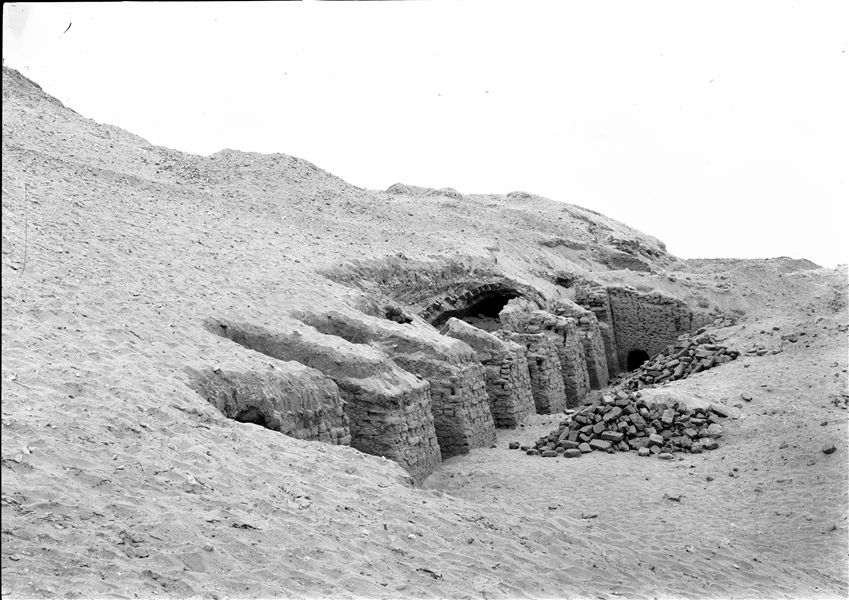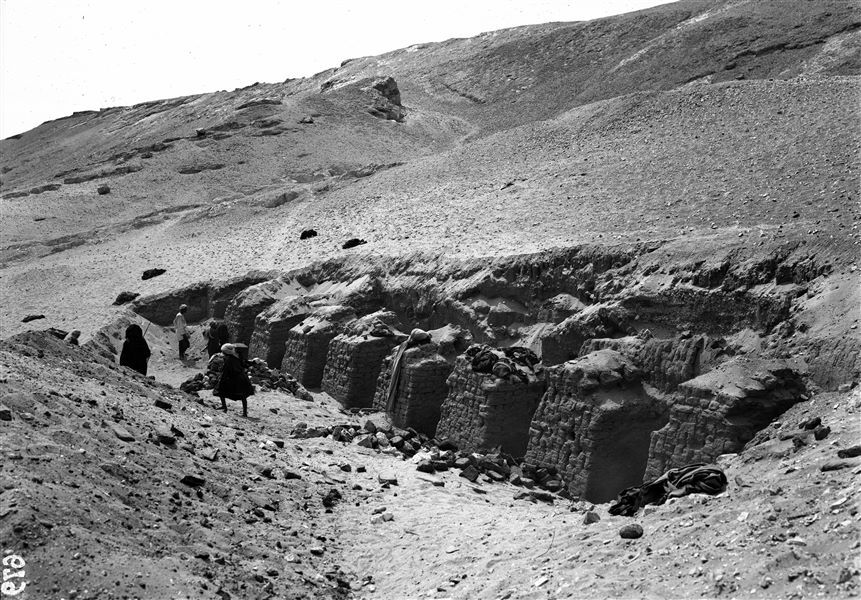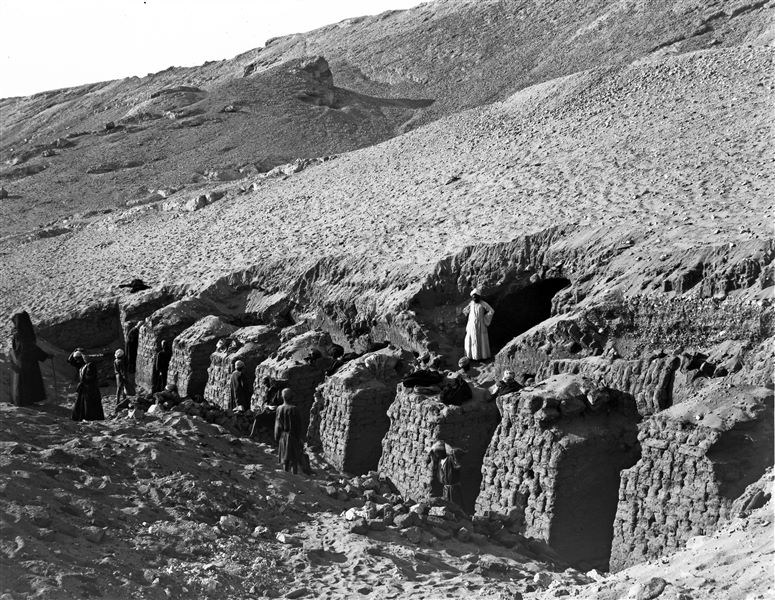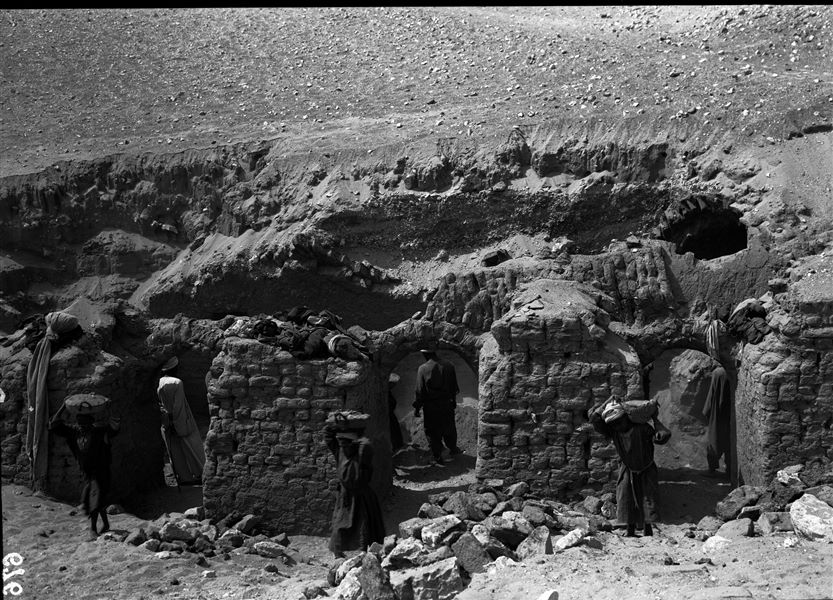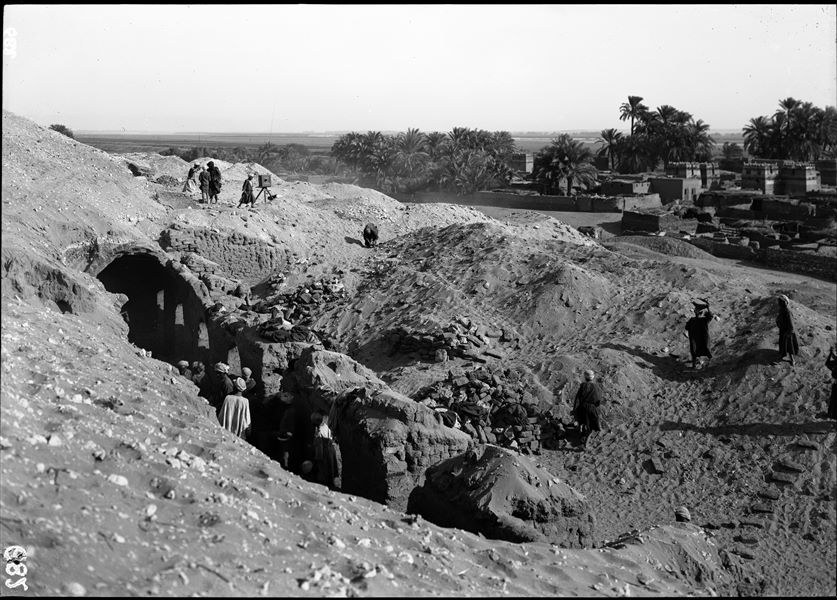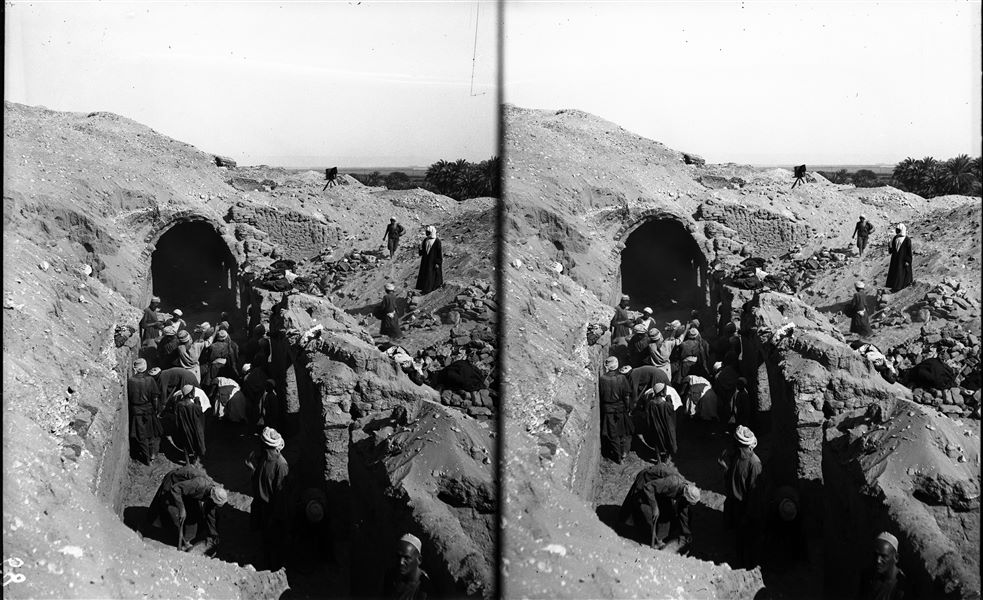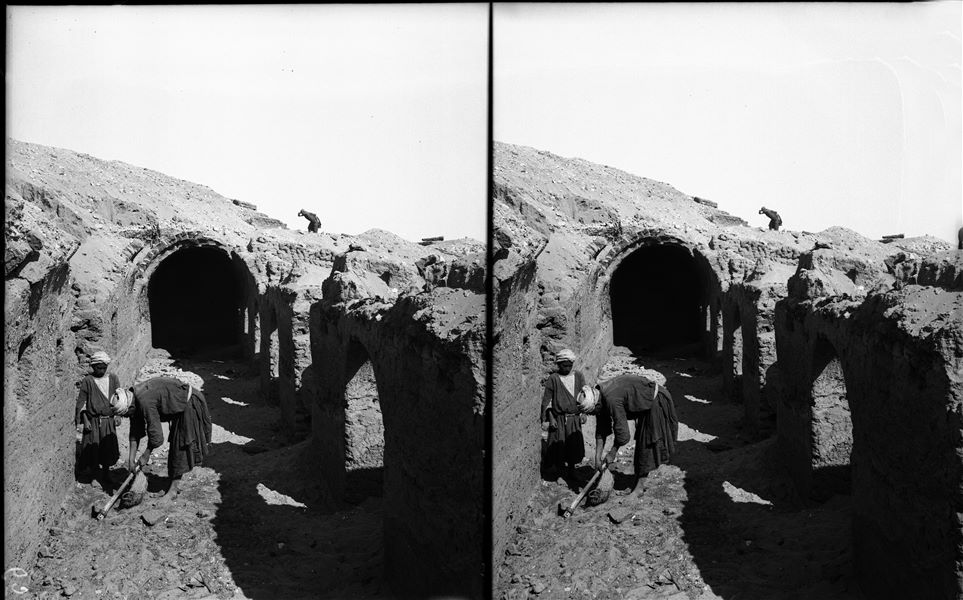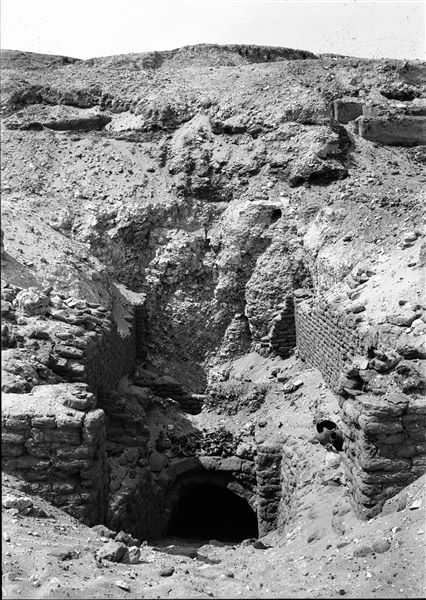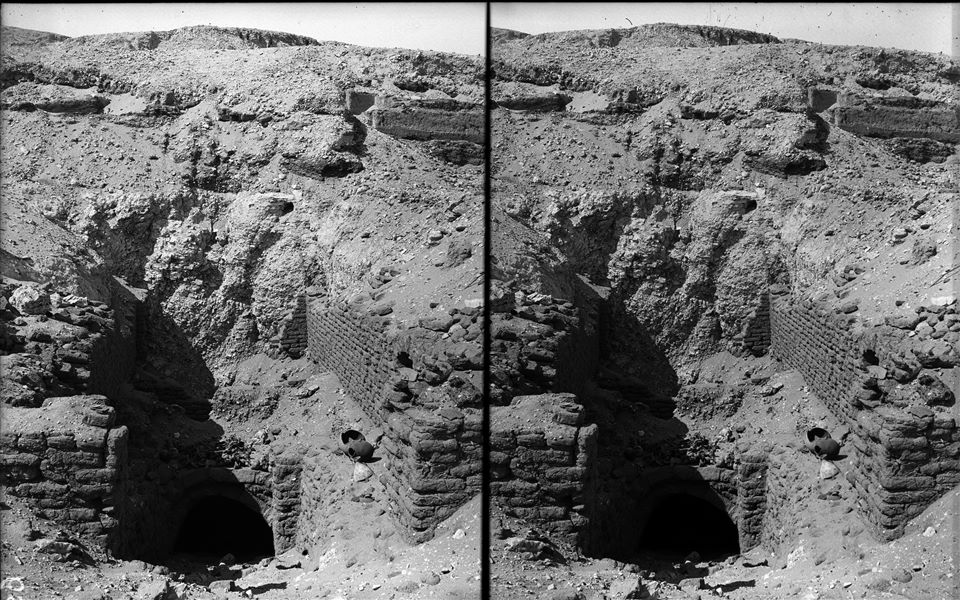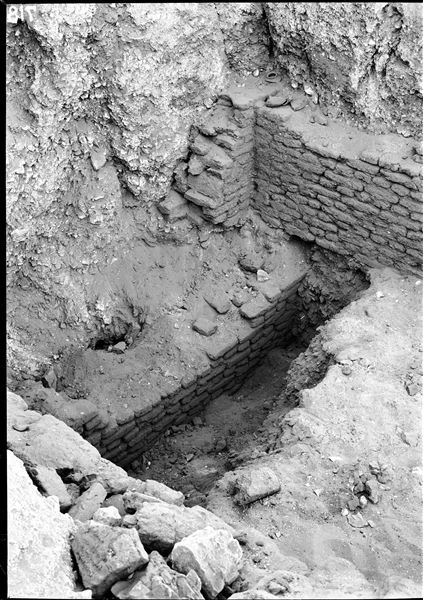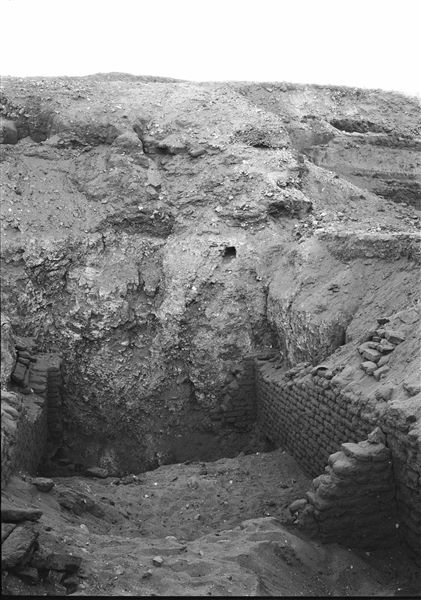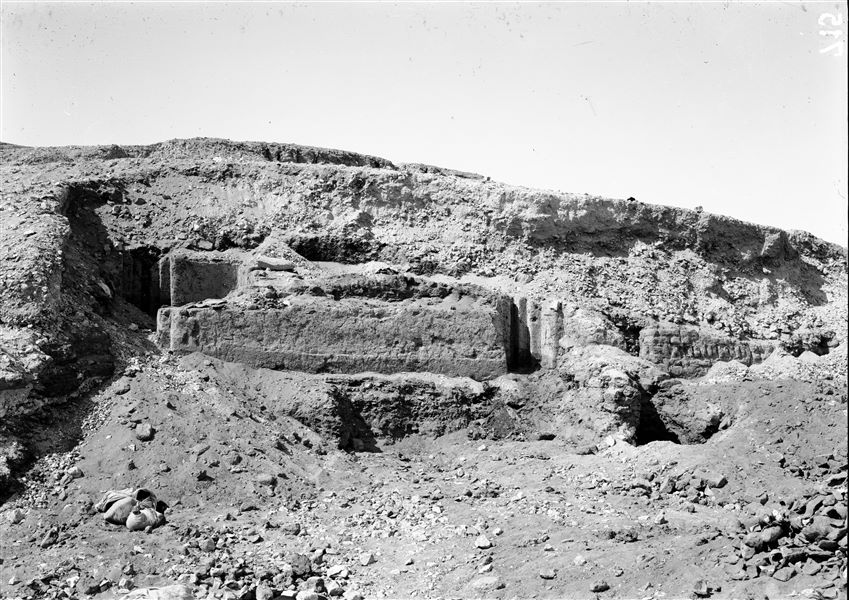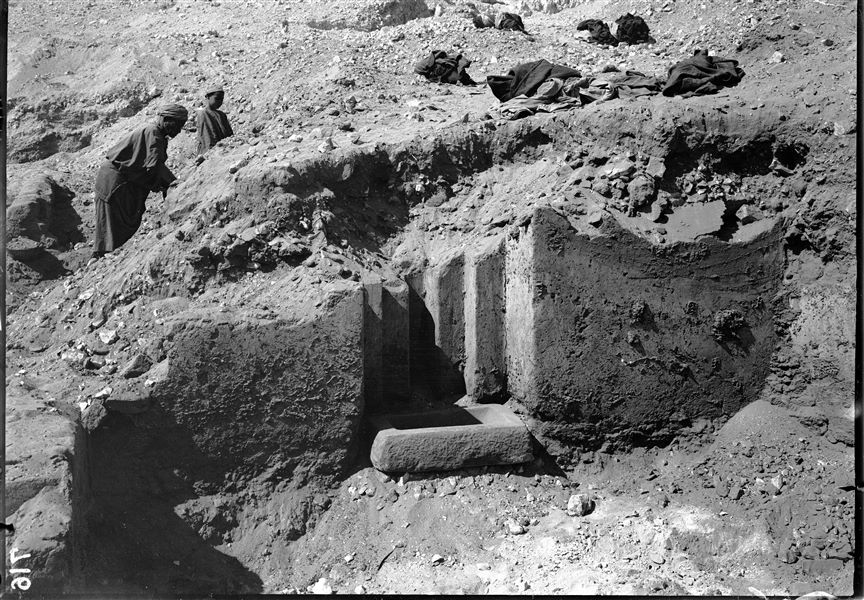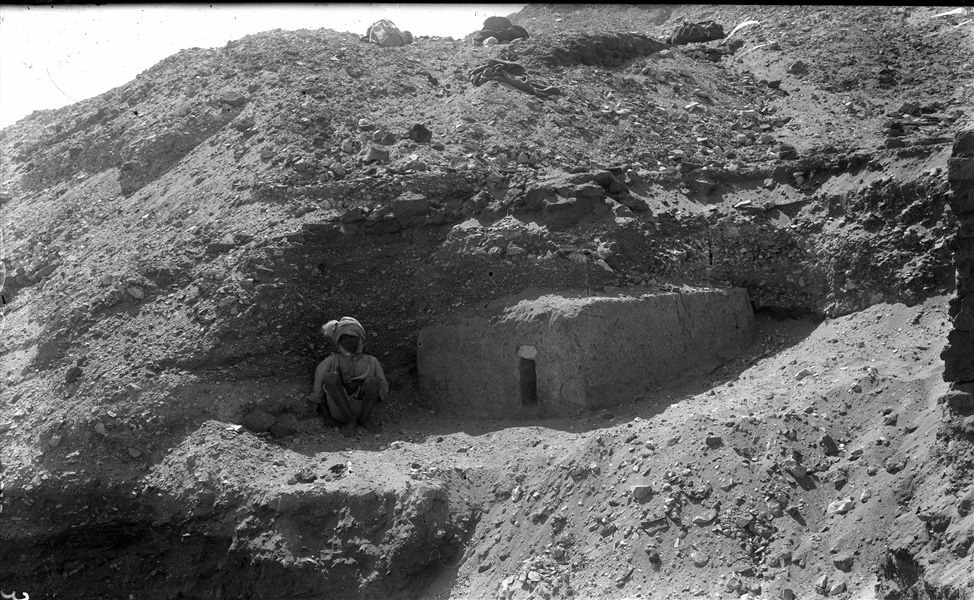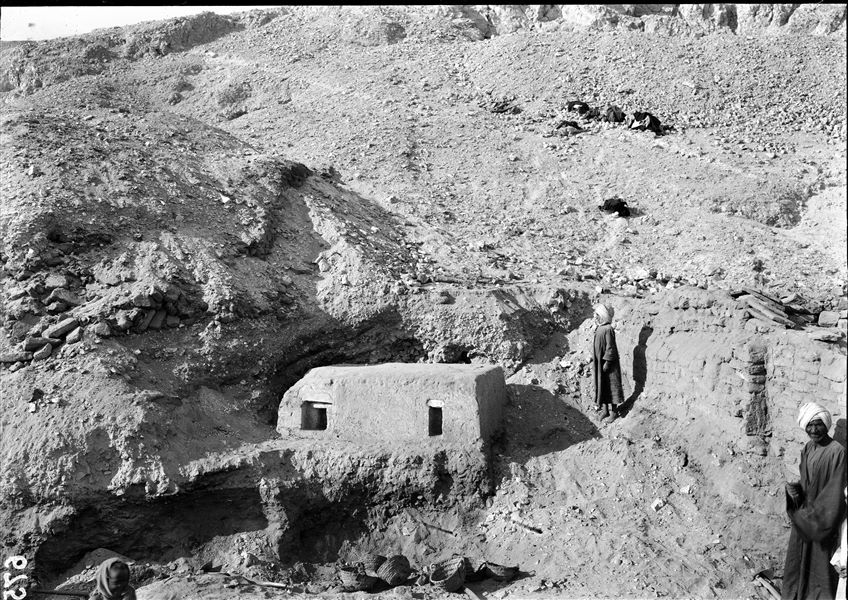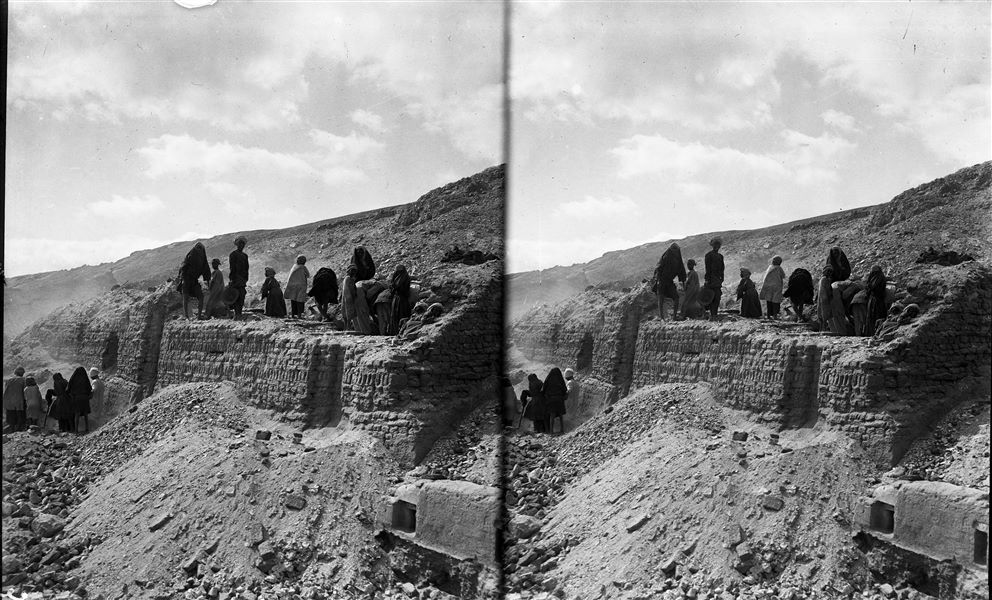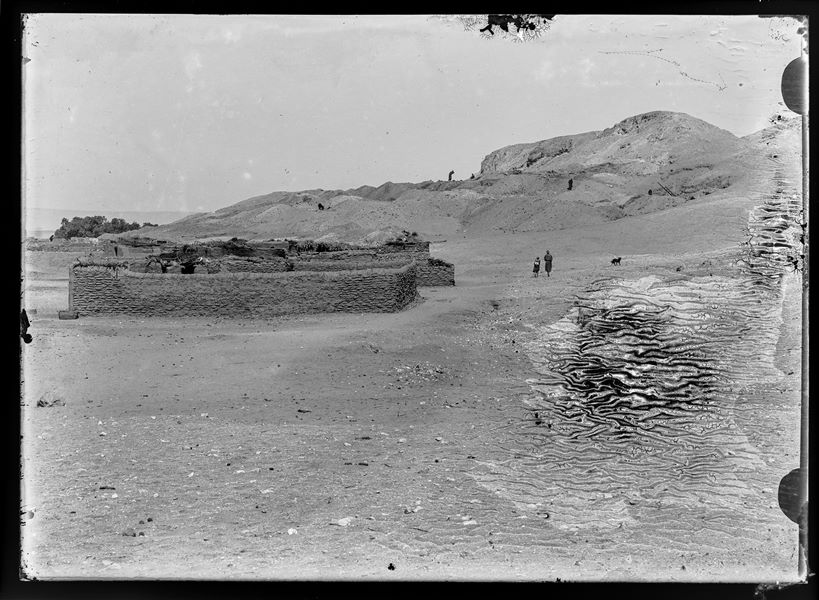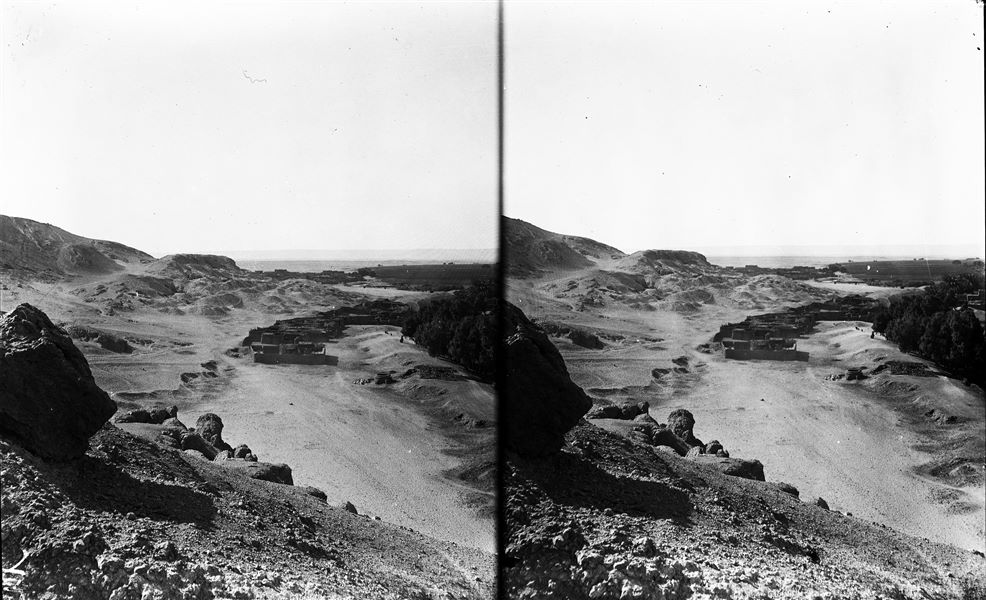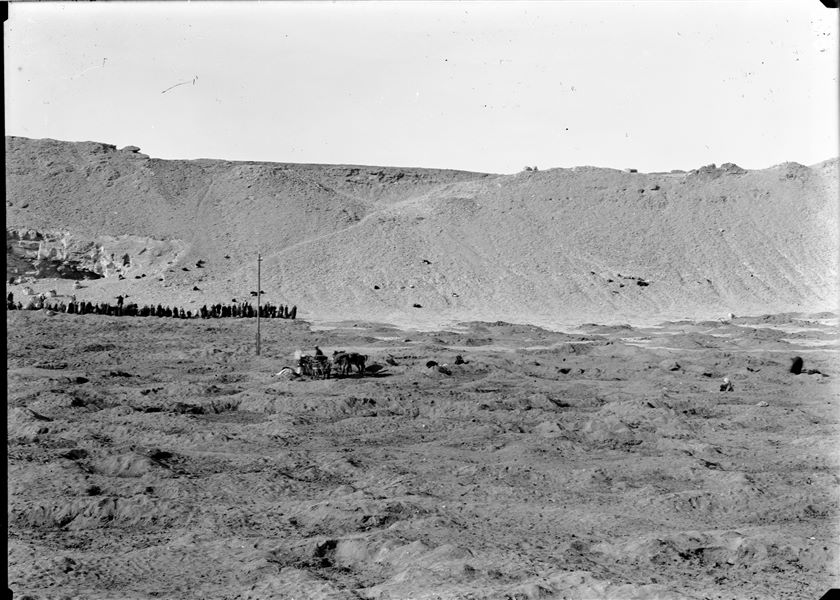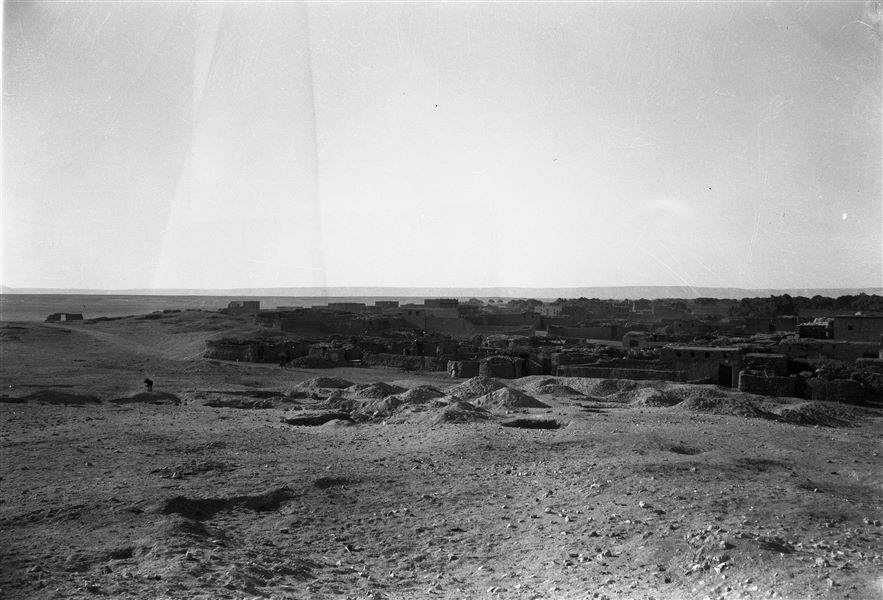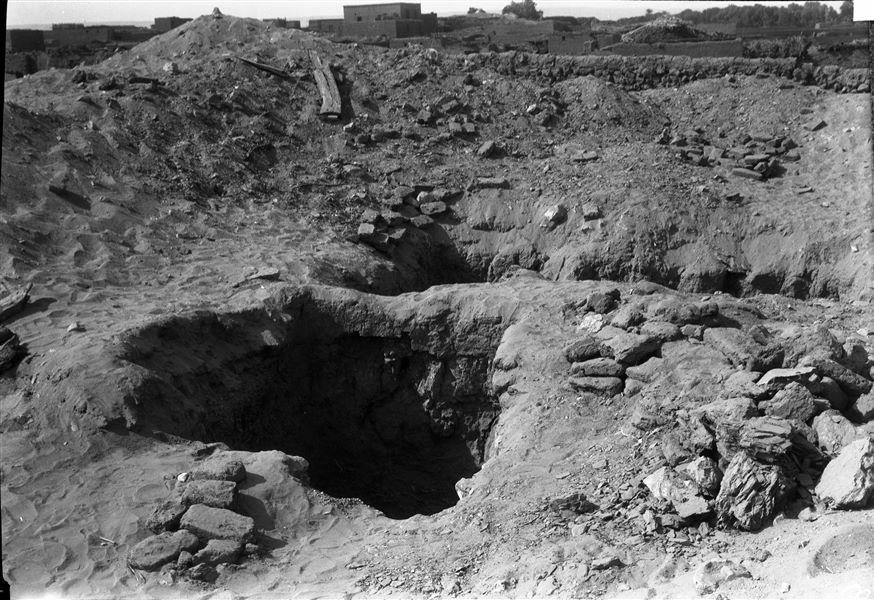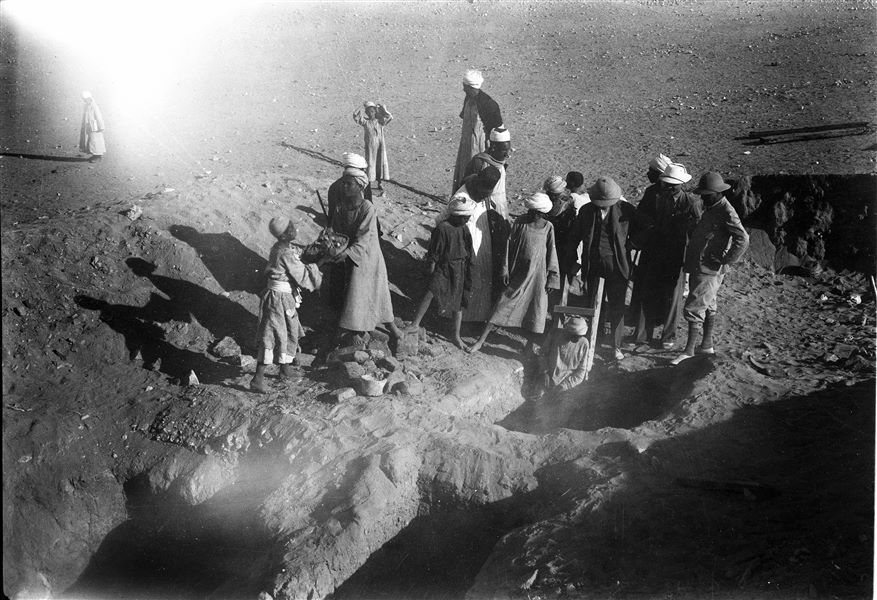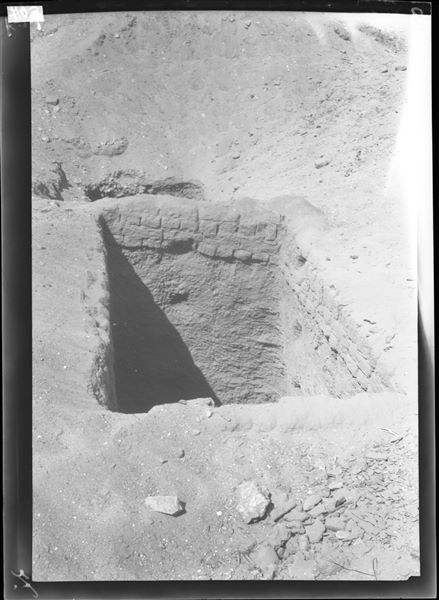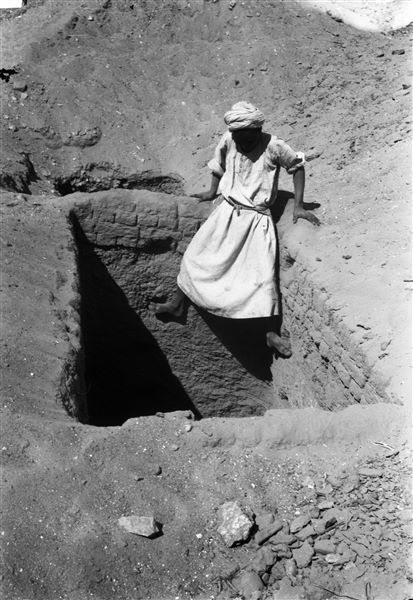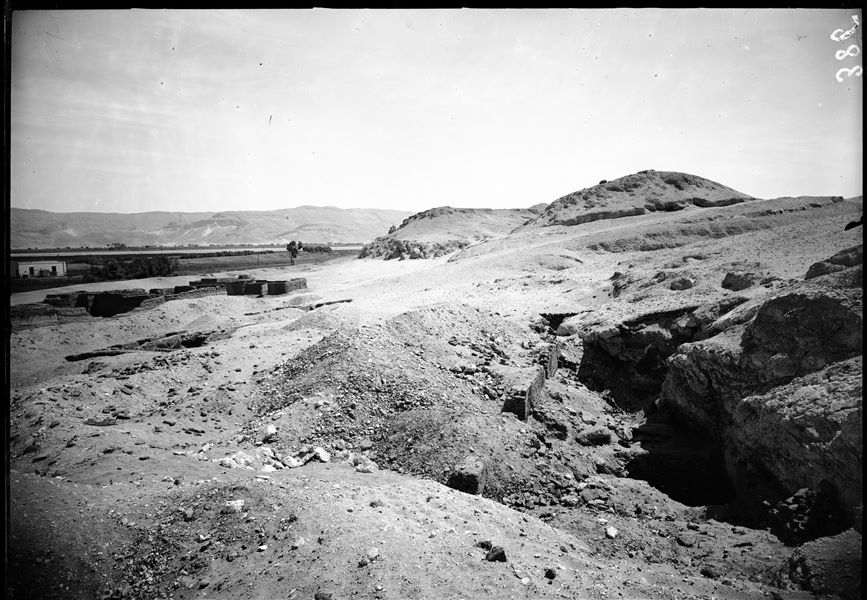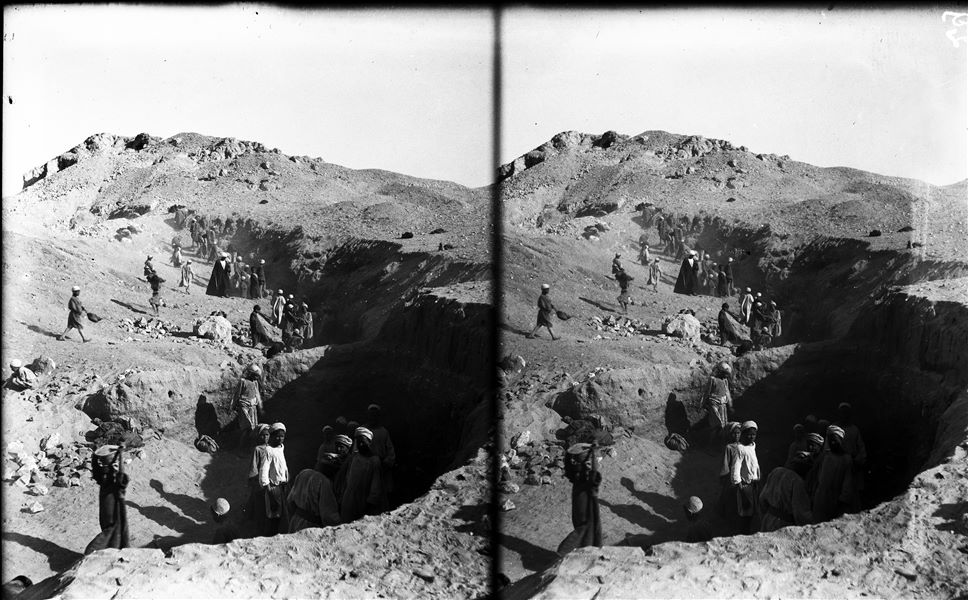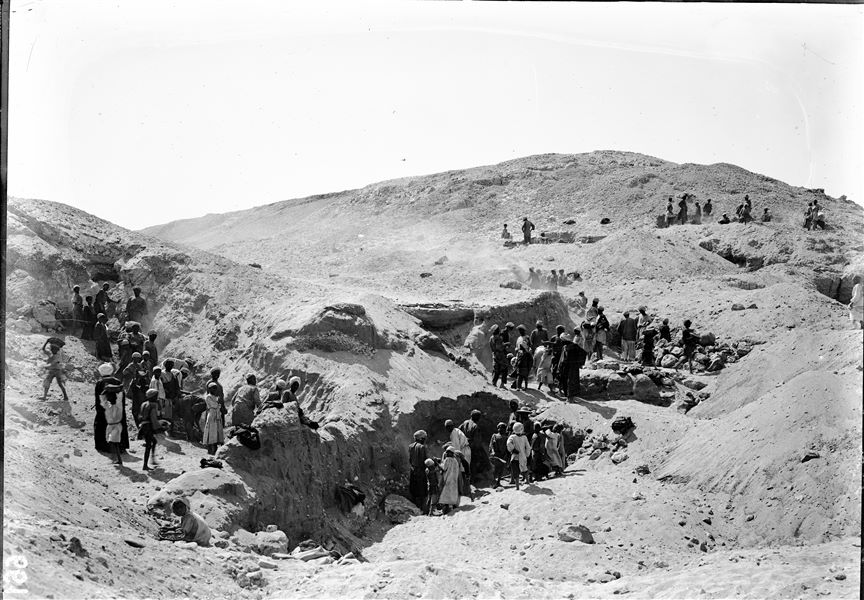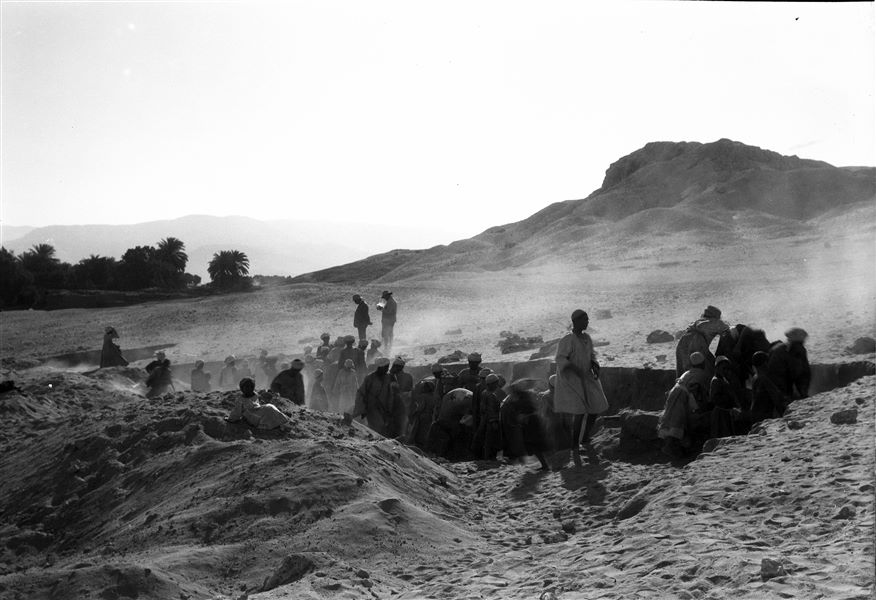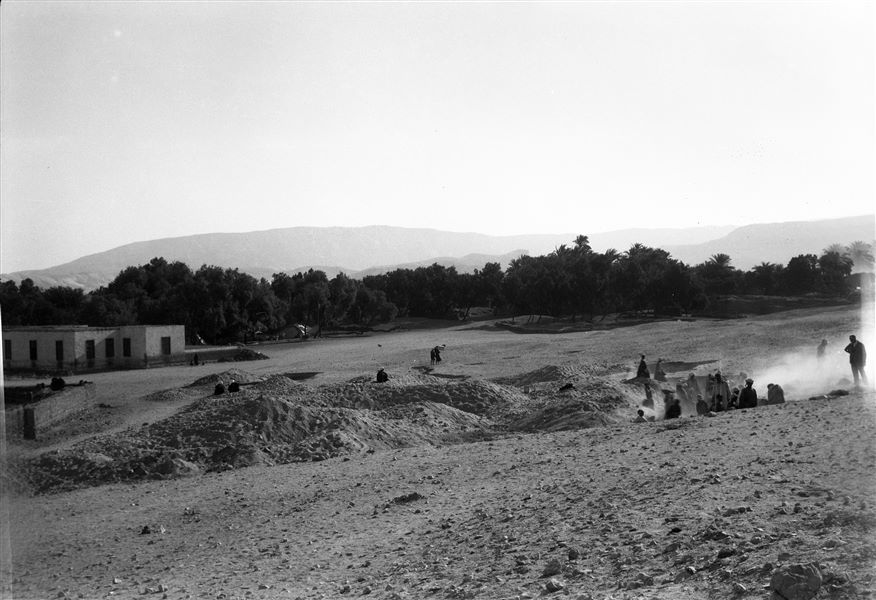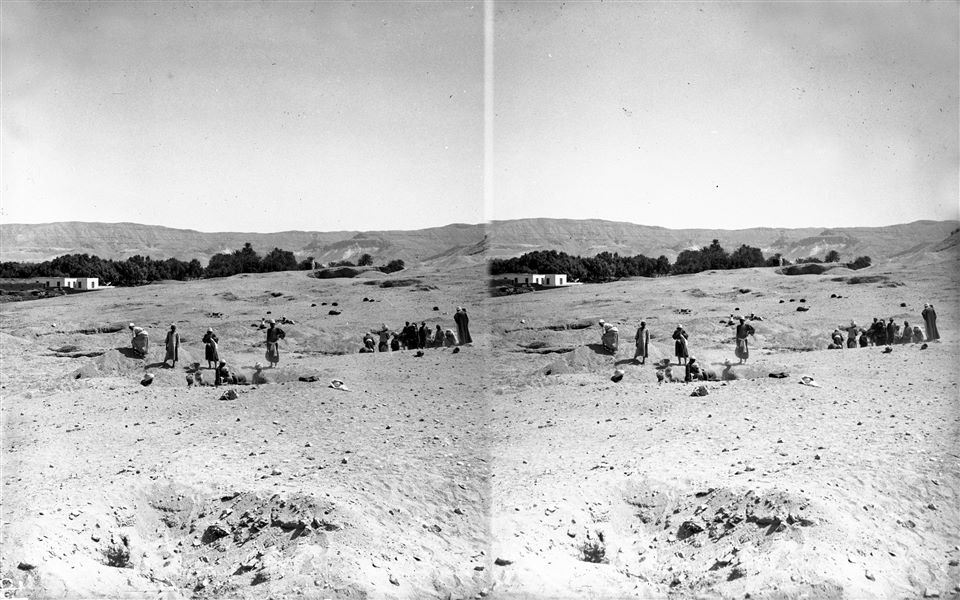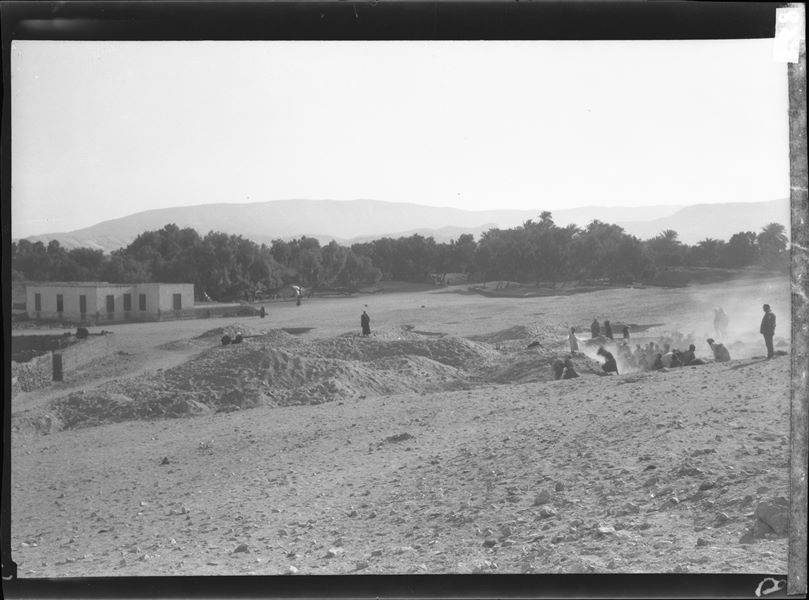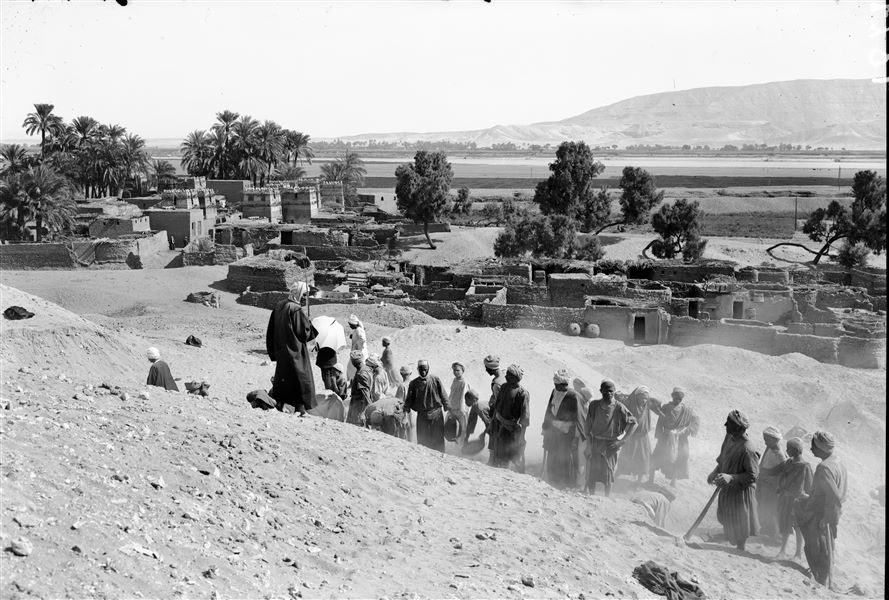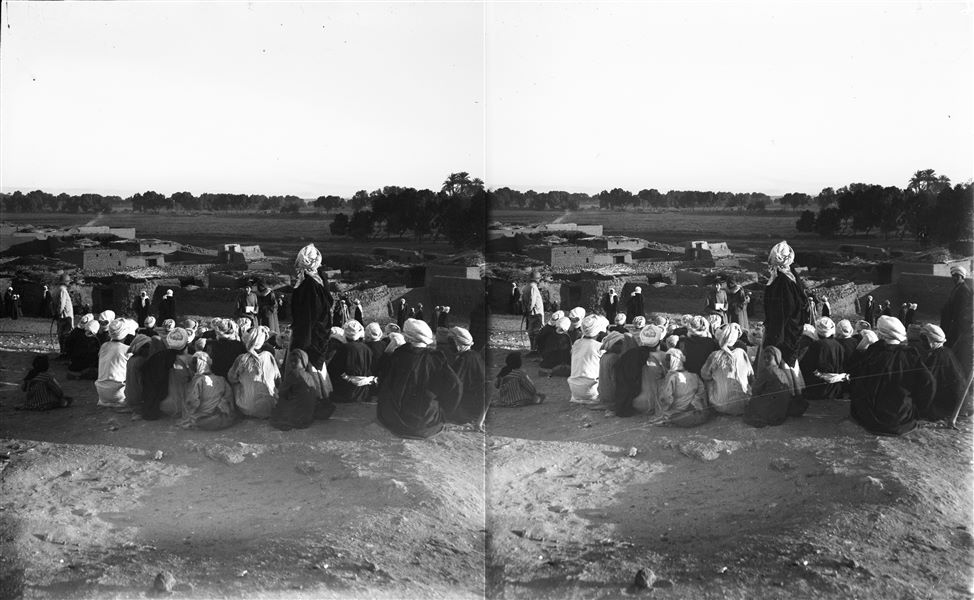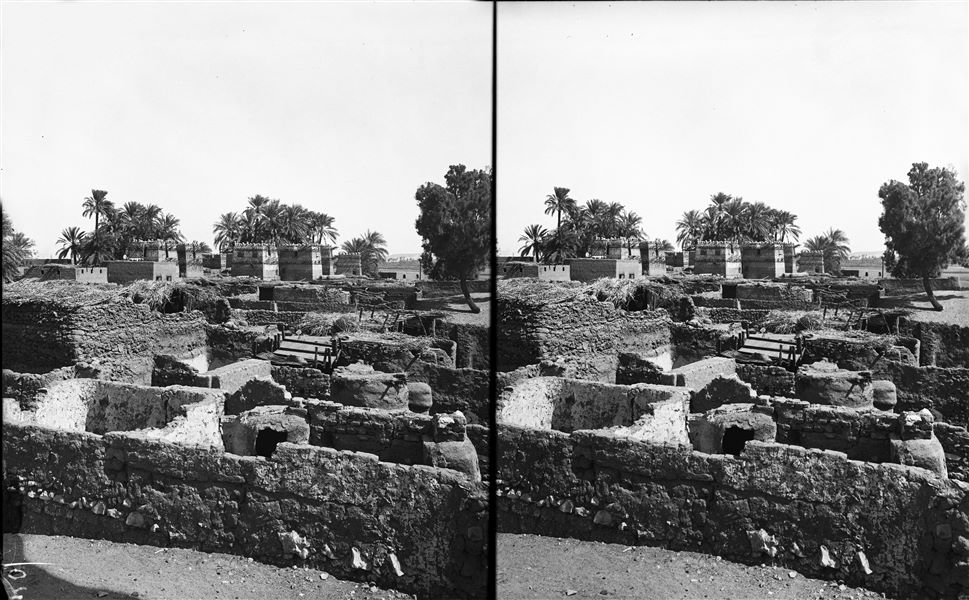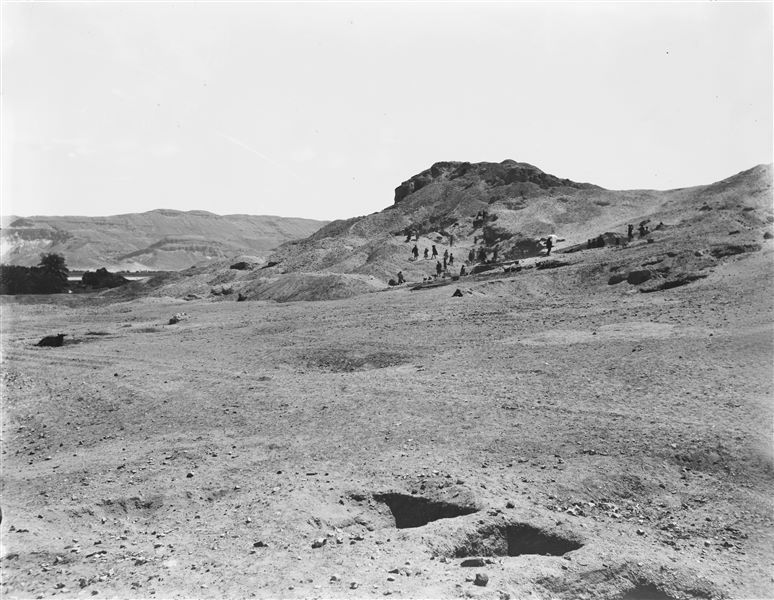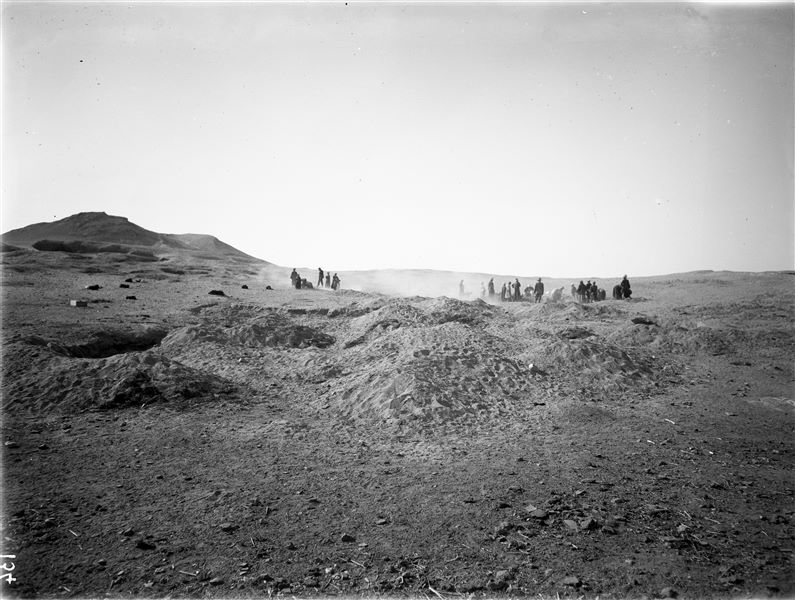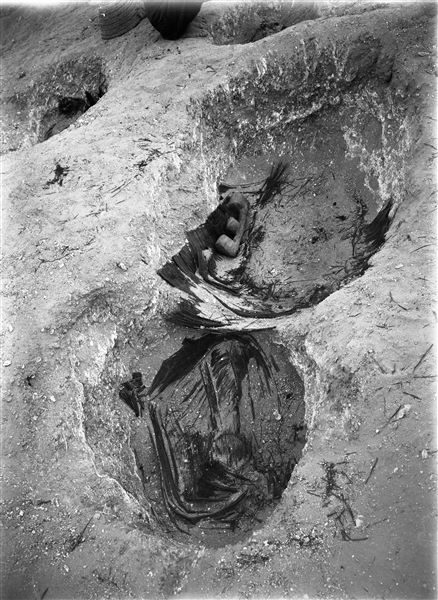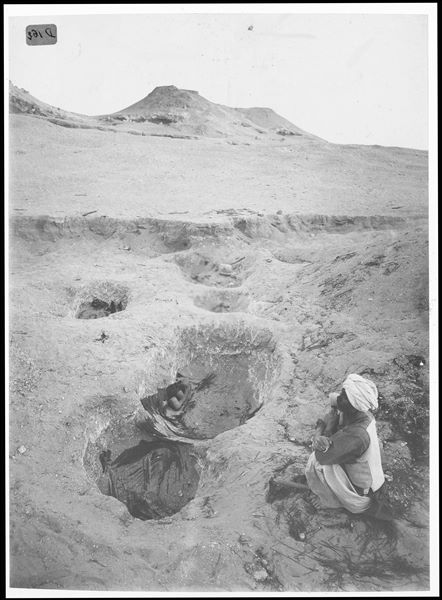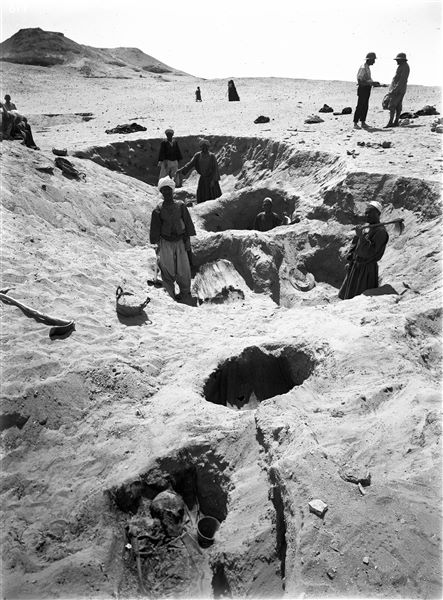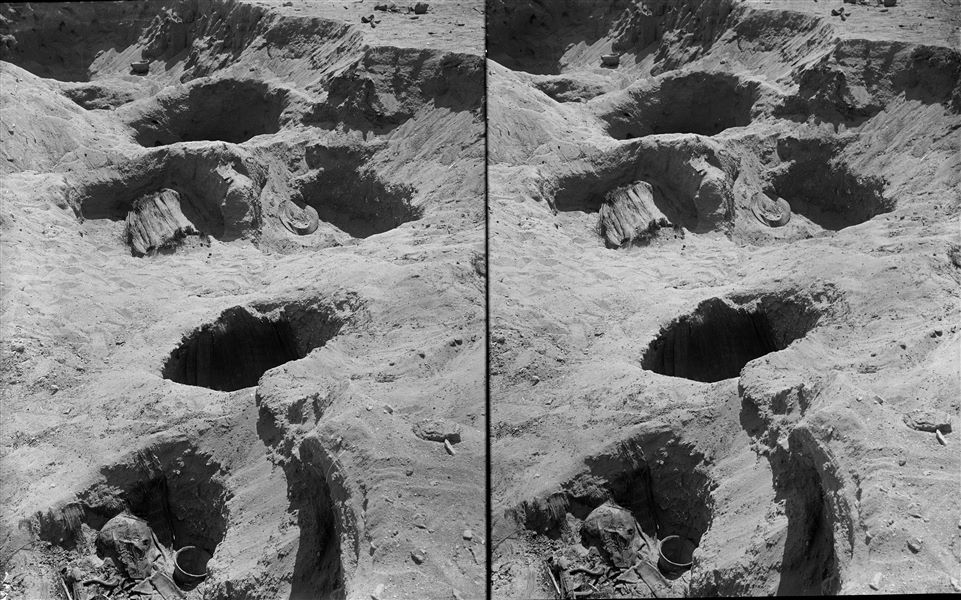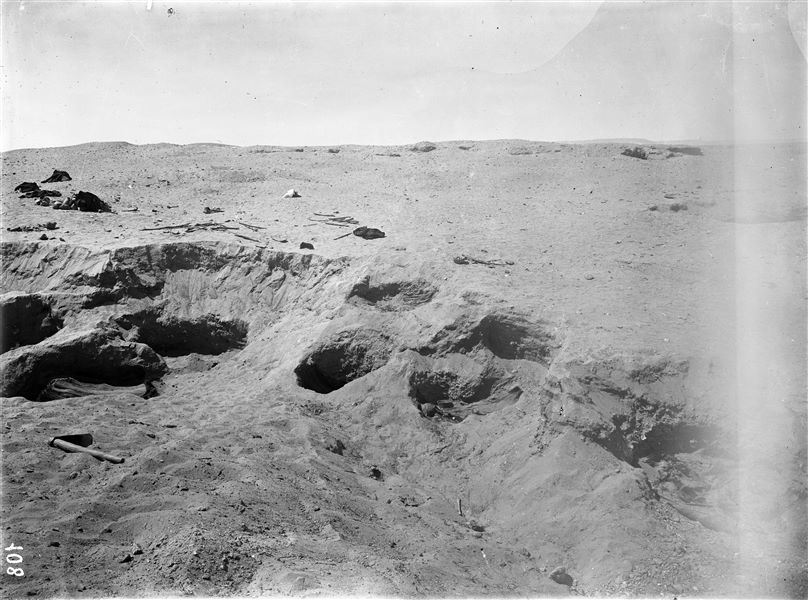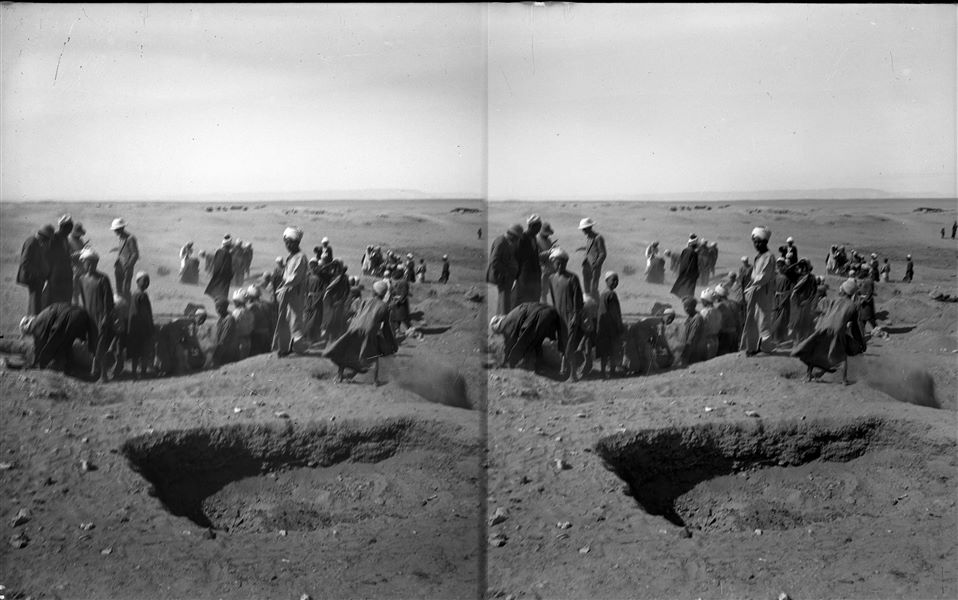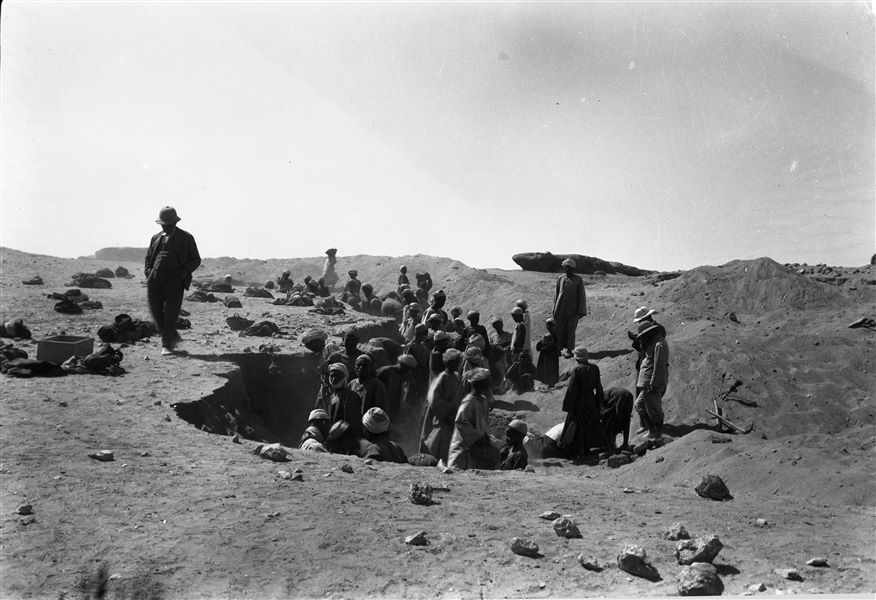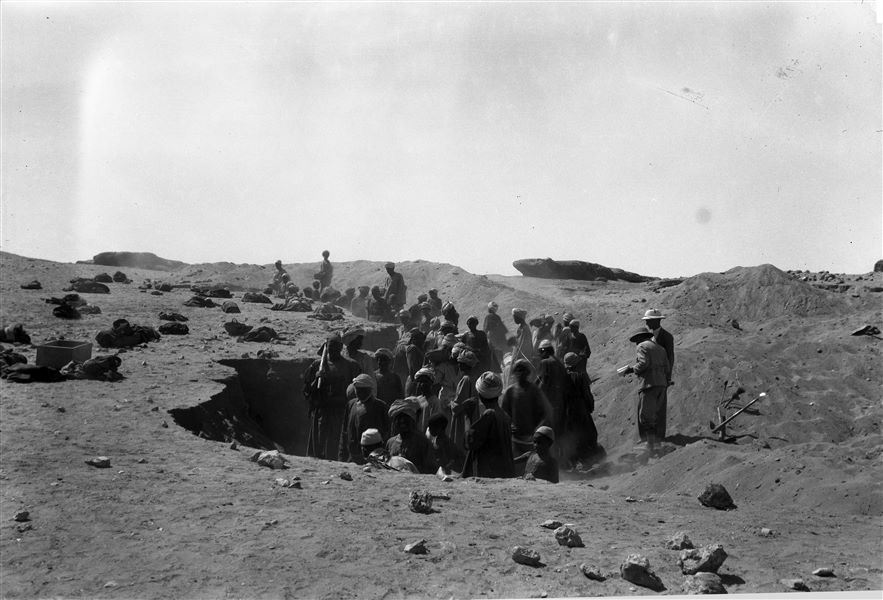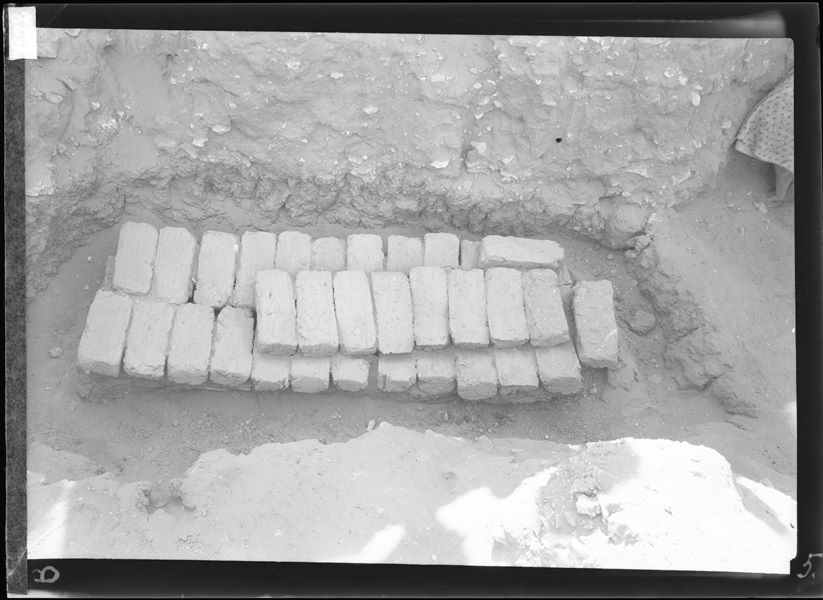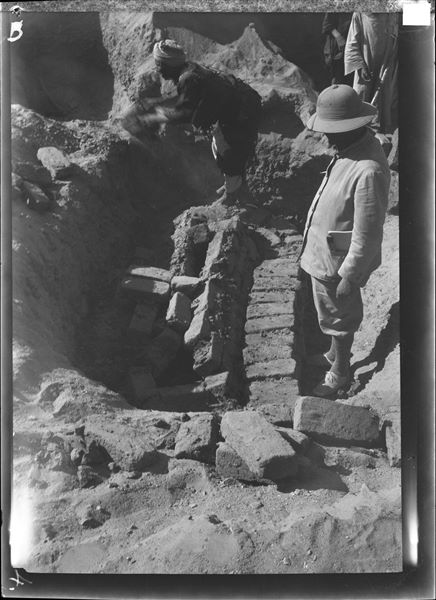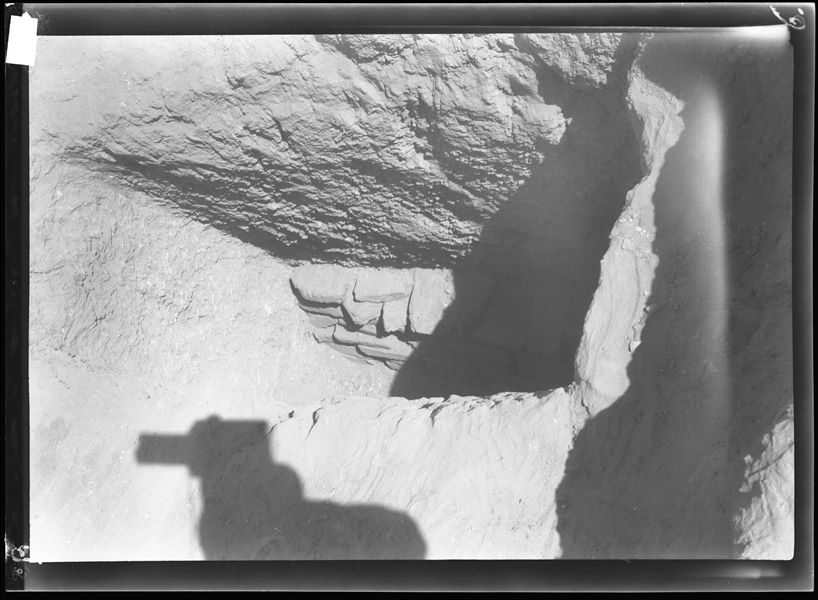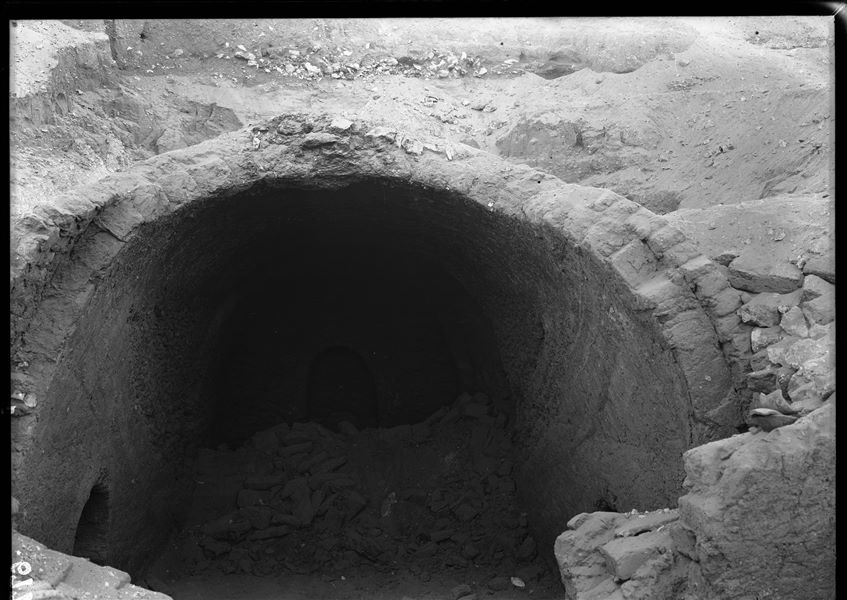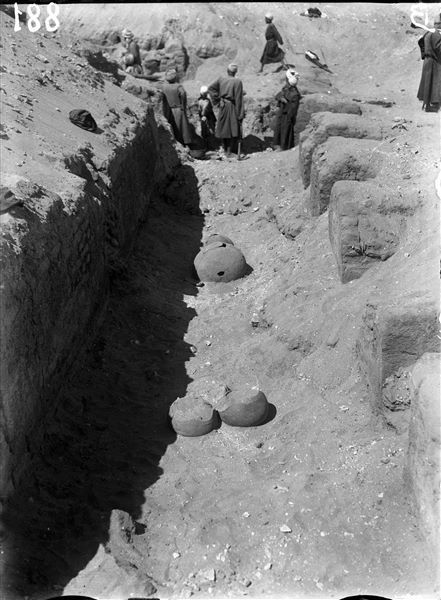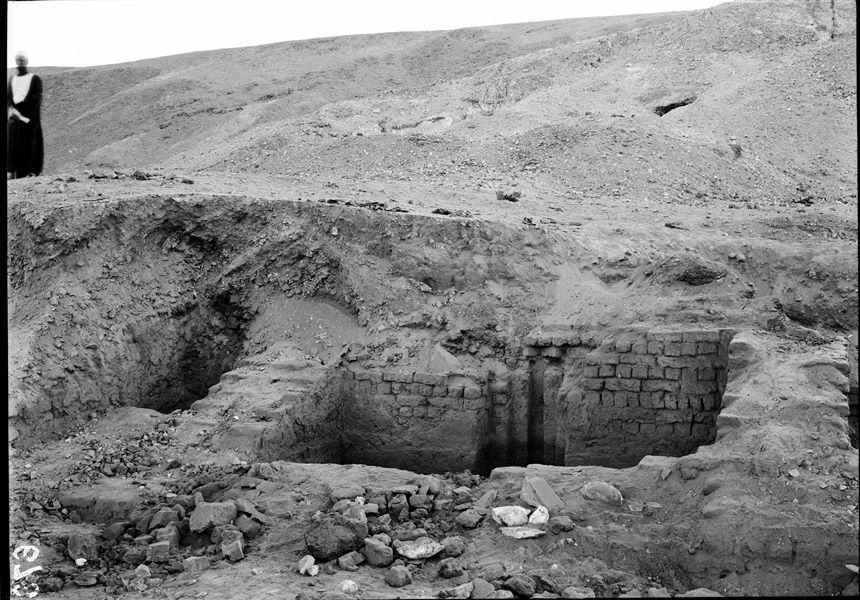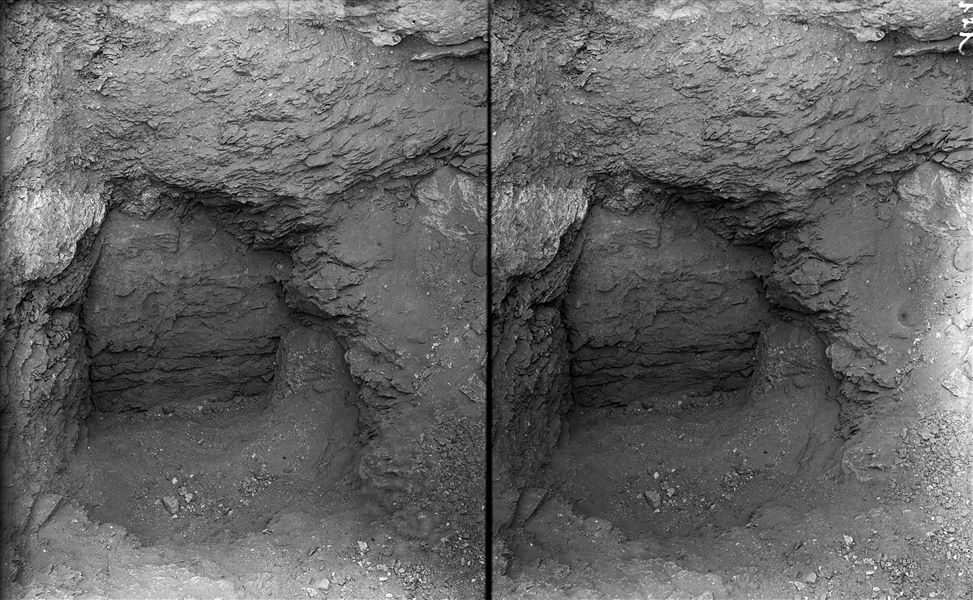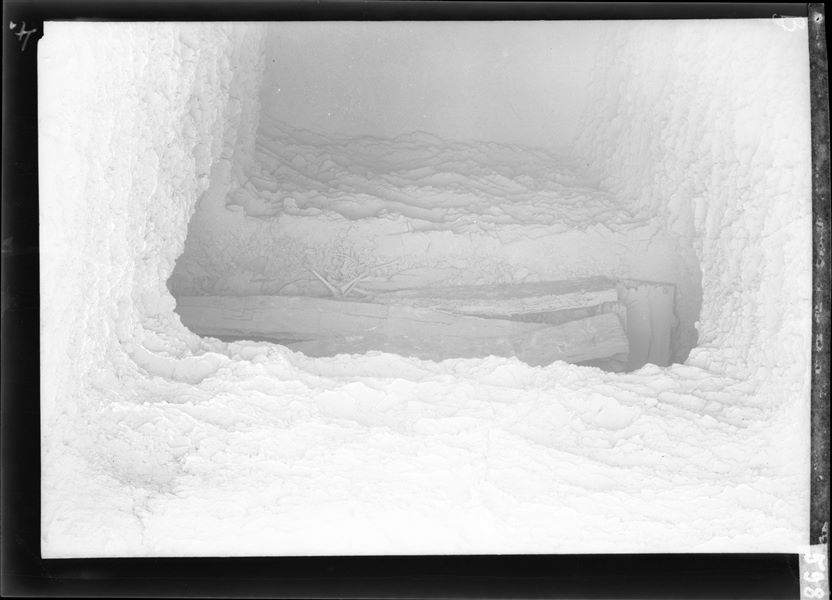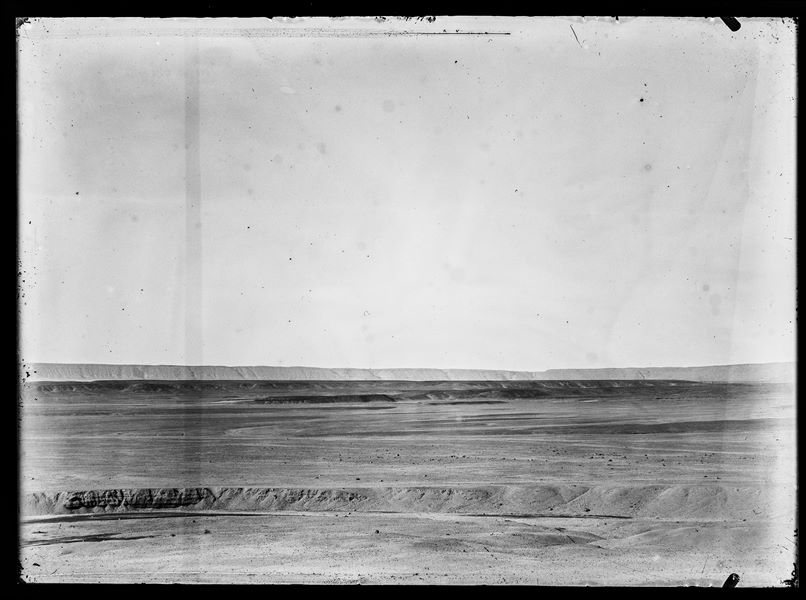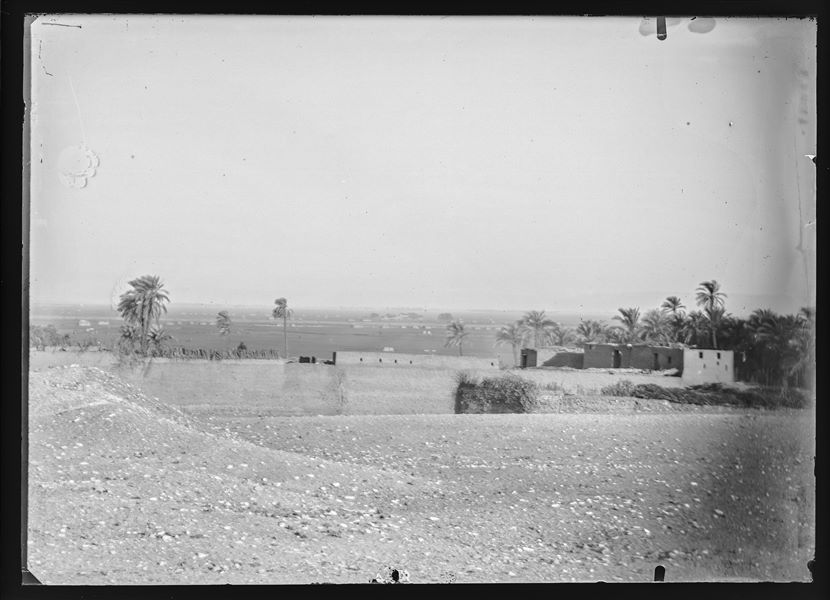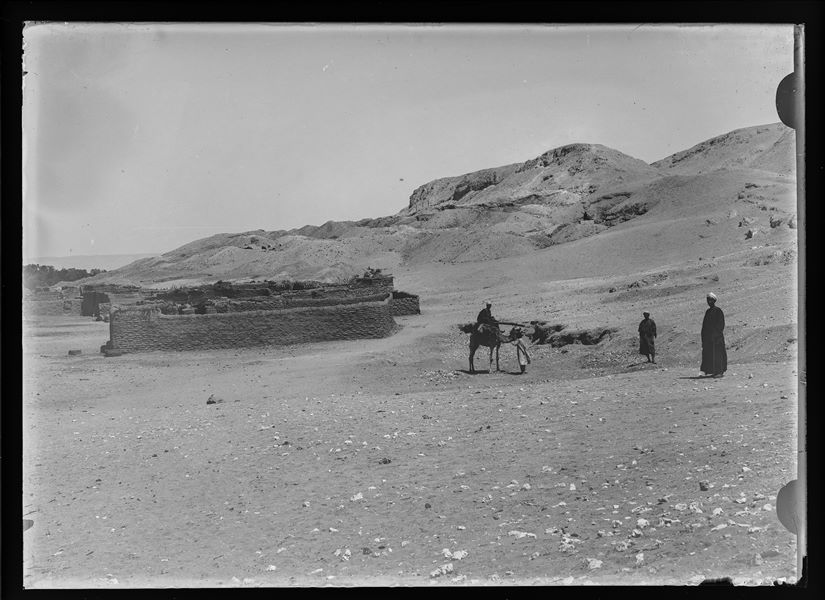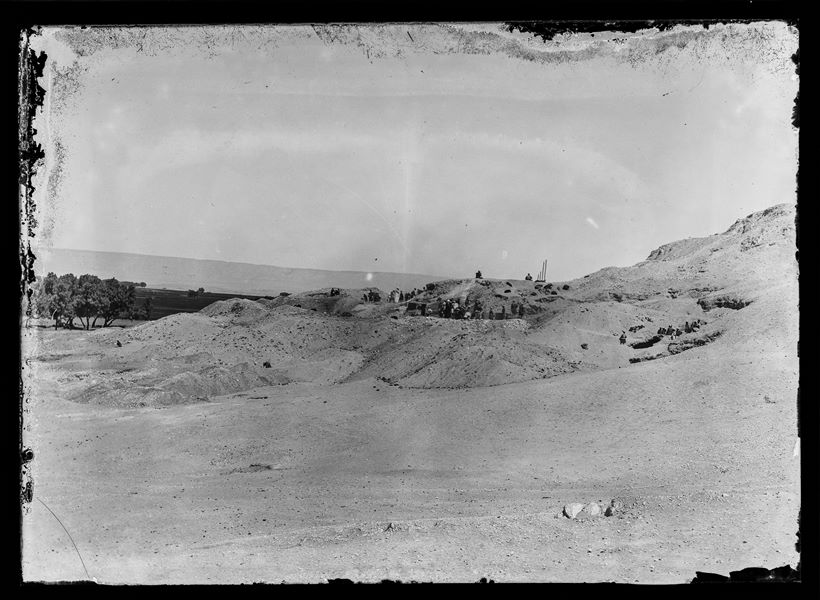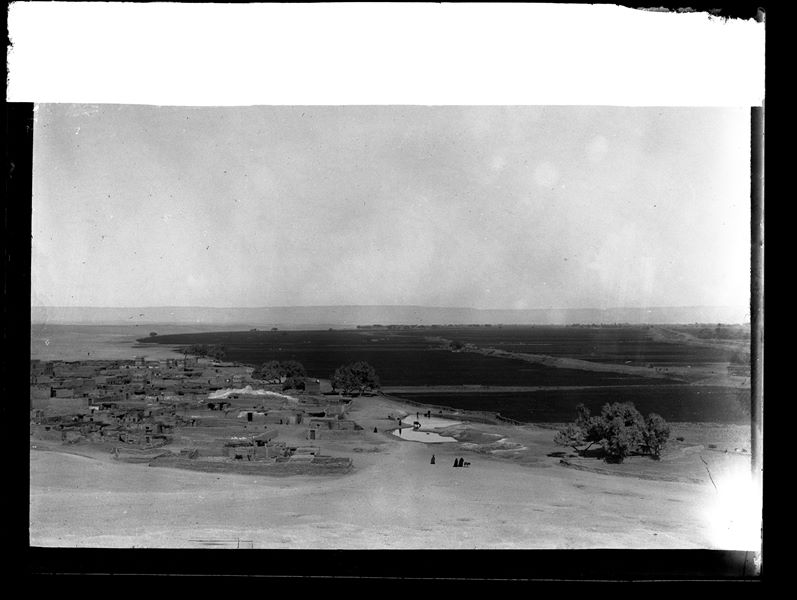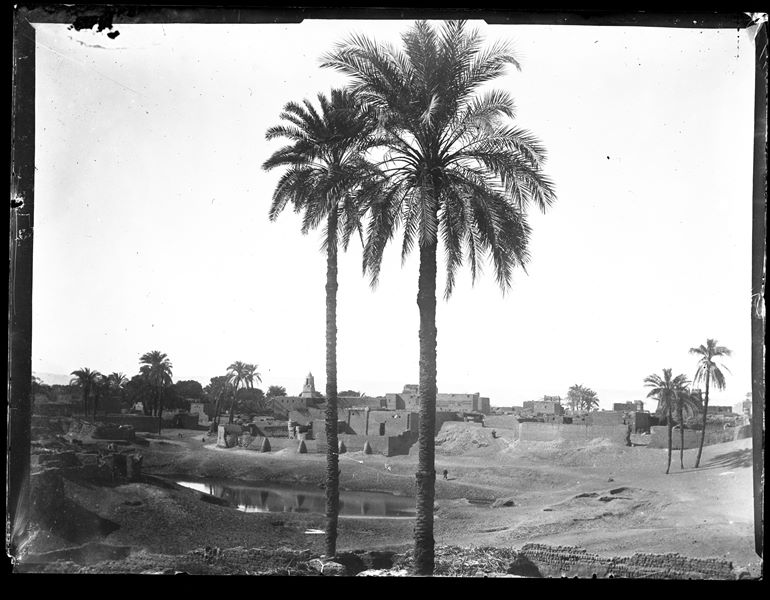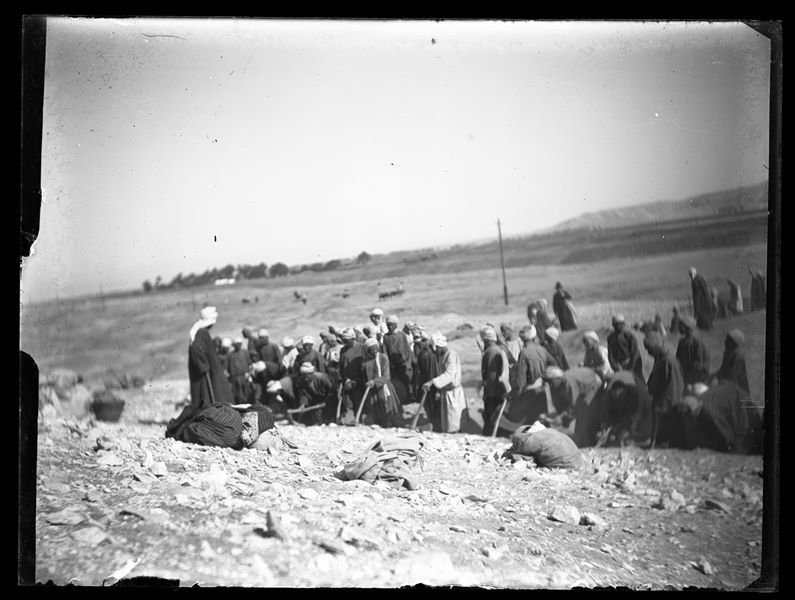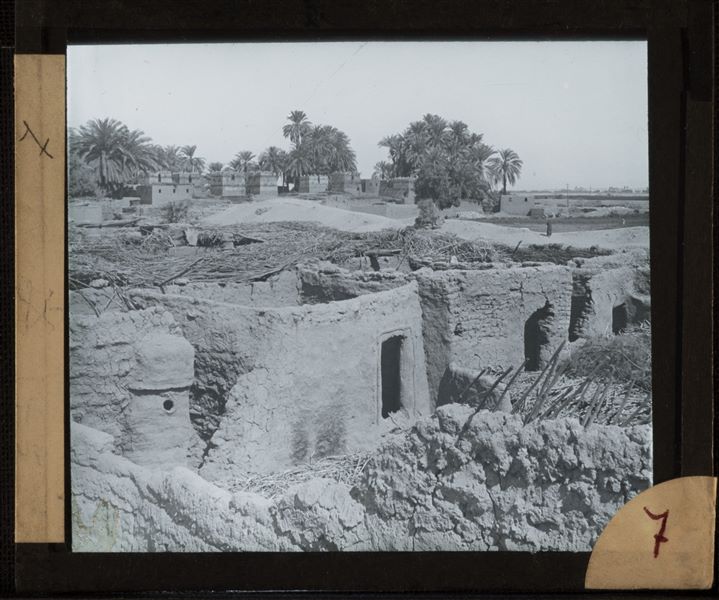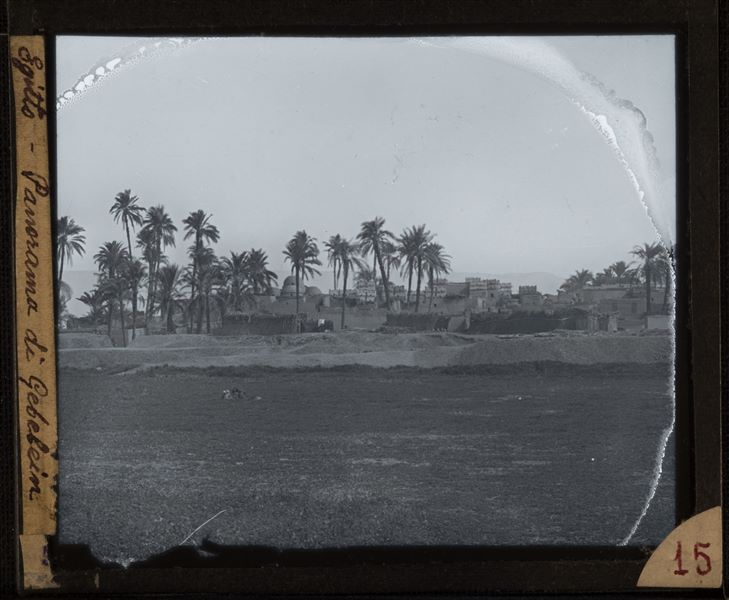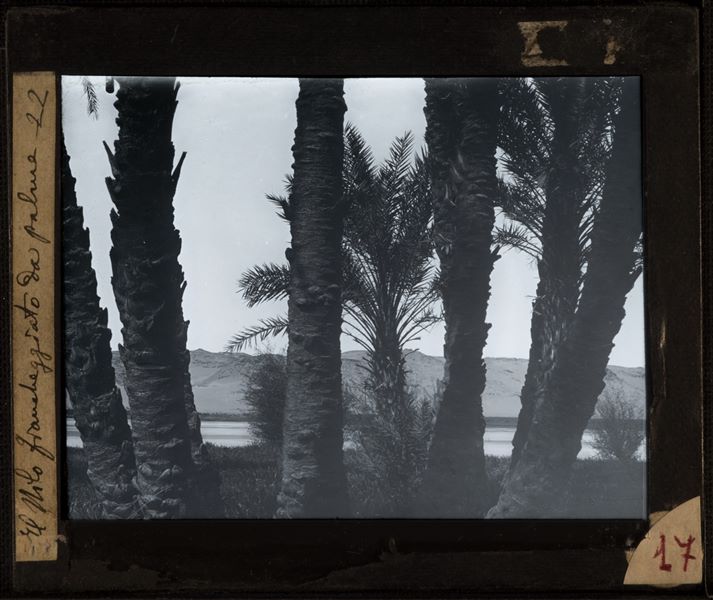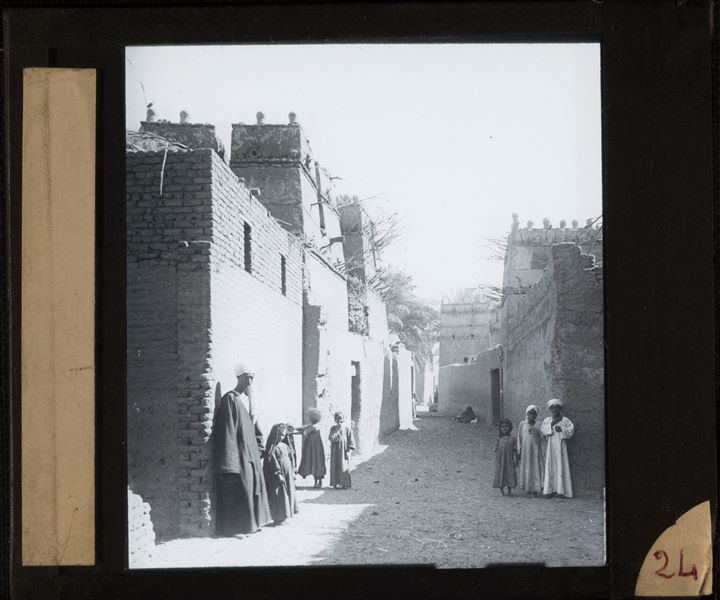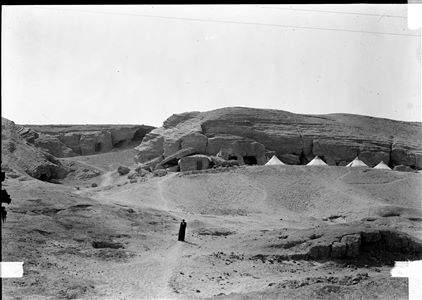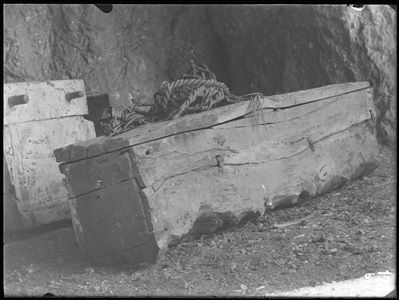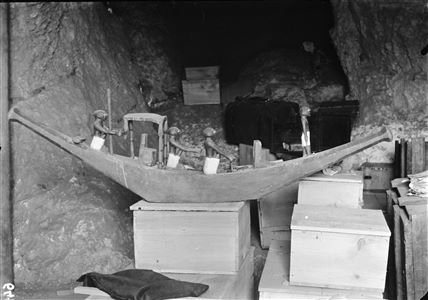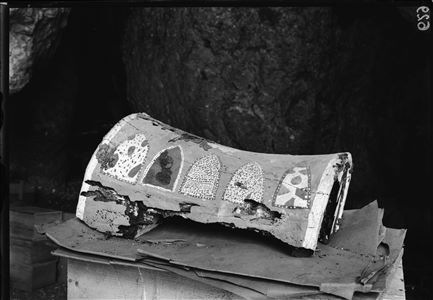Brick structure with a portico at the foot of the hill, east of the village of Abu Hummas, before excavations began. The tomb (now completely lost) could be attributed to Iqer, a local dignitary, some of whose artefacts are preserved in Museo Egizio. Schiaparelli excavations.
Part of the structure of the mud-brick tomb before excavations began. Part of the twelve pillars with joining arches that support the vault of the portico are clearly visible. Schiaparelli excavations.
Mud-brick tomb with portico, beginning of excavation works. Schiaparelli excavations.
Mud-brick tomb with portico. In the middle, the supporting beam of the vault in the central chapel can be seen.
Mud-brick tomb with portico. In the centre, the chapel with a brick vault, during excavations. Schiaparelli excavations.
Mud-brick tomb with portico. Removal of sand from the structural remains, gradually bringing the architecture of the tomb to light. Schiaparelli excavations.
Mud-brick tomb with portico. Excavations. Visible in the background is one of the two cameras used on the excavation site and currently on display at Museo Egizio. On the right, houses from the village of Abu Hummas. Schiaparelli excavations.
Mud-brick tomb with portico. Excavations. Visible on the right is one of the two plate cameras used on the excavation site and currently on display at Museo Egizio. Schiaparelli excavations.
Mud-brick tomb with portico. Excavations. Visible in the background is the retaining wall of the courtyard in front of the tomb. Schiaparelli excavations.
Mud-brick tomb with portico. Excavating the end of the portico. The retaining wall of the courtyard sloping down towards the valley is clearly visible, as well as the second plate camera used by the mission. Schiaparelli excavations.
Mud-brick tomb with portico. Works finalising the cleaning of the corridor pavement. Schiaparelli excavations.
Northern necropolis. Perimeter walls bordering a room leading to a burial shaft. From the limited information available, this could be the tomb of Iqer. Museo Egizio houses some finds from this individual. Above on the right are the remains of the mastaba of Perim. Schiaparelli excavations.
Northern necropolis. Remains of mud-brick structures bordering a room with access to a descending gallery in its centre. Schiaparelli excavations.
Northern necropolis. Perimeter walls bordering a room which leads to the burial shaft. Schiaparelli excavations.
Northern necropolis. Remains of mud-brick structures bordering a room with access to a descending gallery in its centre. Some parts of the structures were dismantled to avoid a potential collapse during excavations. Schiaparelli excavations.
Northern necropolis. Remains of the plastered mud-brick structures from the mastaba of Perim. On the right, a false-door is visible. The tomb consisted of several burial shafts with small rooms. The contents, which were found intact, were severely damaged by termites that completely destroyed the sarcophagi and the wooden grave goods. Schiaparelli excavations.
Northern necropolis. Mastaba of Perim. At the base of one of the false-doors, a rectangular stone basin for offerings was found. The name of the owner Perim is present on one of the longer sides of the object (S.15736). Schiaparelli excavations.
Northern necropolis. A small burial structure in the form of a mastaba. Schiaparelli excavations.
Northern necropolis. A small burial structure in the form of a mastaba. Schiaparelli excavations.
Northern necropolis. A small burial structure in the form of a mastaba. Schiaparelli excavations.
Northern necropolis. Mud-brick mastaba, before excavations began. Visible on the left is the small structure present in photograph C00675. Schiaparelli excavations.
Northern necropolis. Mud-brick mastaba during excavations. Visible on the left is the small structure present in photograph C00675. Schiaparelli excavations.
Northern Necropolis. Excavating a mastaba on the top of the hill. Schiaparelli excavations.
Northern Necropolis. Excavating on the upper part of the hill. Ernesto Schiaparelli can be identified in this photograph. He is in the centre under a white parasol, around him are three clergymen from the Franciscan Mission of Luxor. The person on the right wearing a pith helmet (colonial style helmet) is not identifiable. Schiaparelli excavations.
Northern necropolis. From a note made by Virginio Rosa, who conducted the excavations on behalf of Ernesto Schiaparelli during the 1910-11 campaign, he writes: "Entrance to the intact tomb excavated on 27-1-11". This tomb was later known as the "Tomb of the Unknown". The mummies and all the grave goods from this tomb are housed at Museo Egizio. Schiaparelli excavations.

Workers along the eastern slopes of the northern hill. In the foreground, the remains of a mud-brick structure. Schiaparelli excavations.
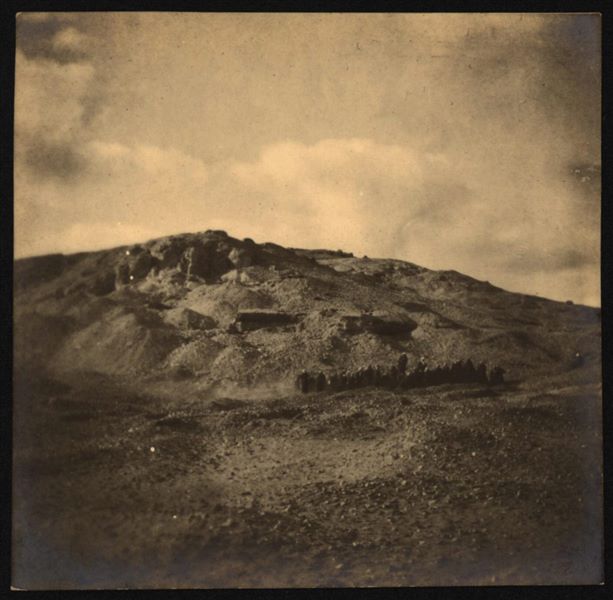
Excavations at the foot of the northern hill. In the background, the remains of ancient mud-brick walls. Schiaparelli excavations.
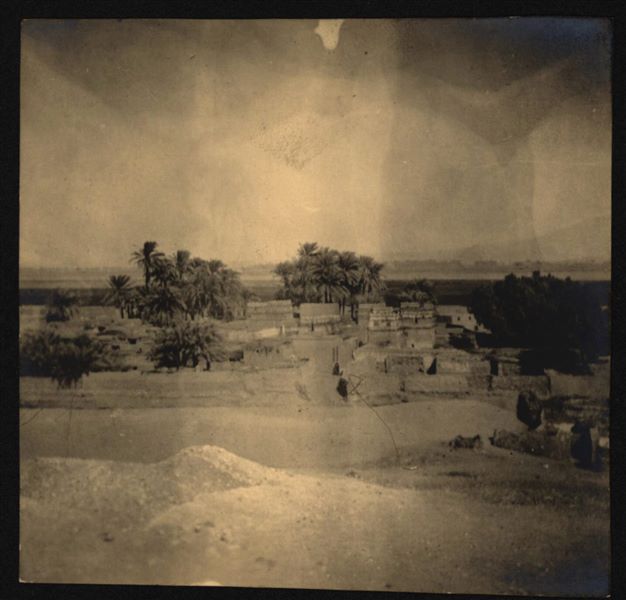
Partial view of the village of Naga el-Gherira, taken from the slopes of the northern hill. Schiaparelli excavations.

Rock formation in the Gebelein area. Schiaparelli excavations.
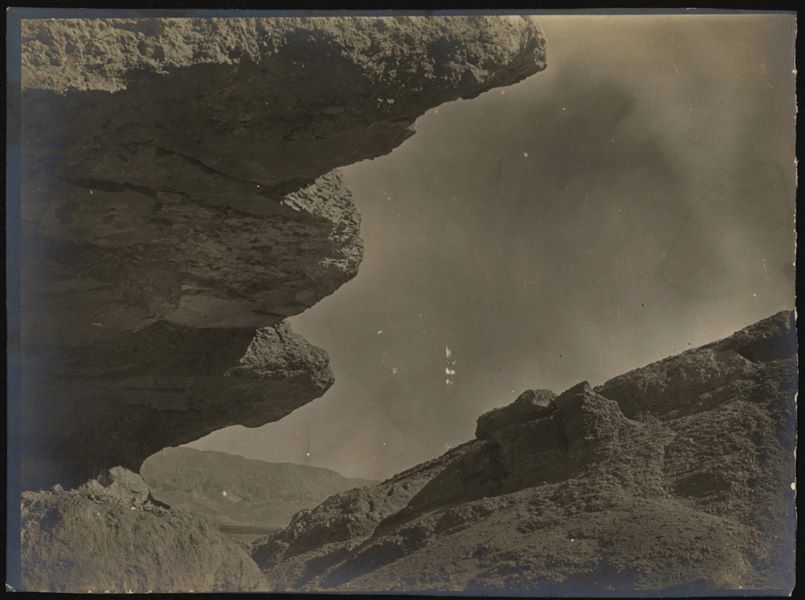
Rock formation in the Gebelein area. Schiaparelli excavations.
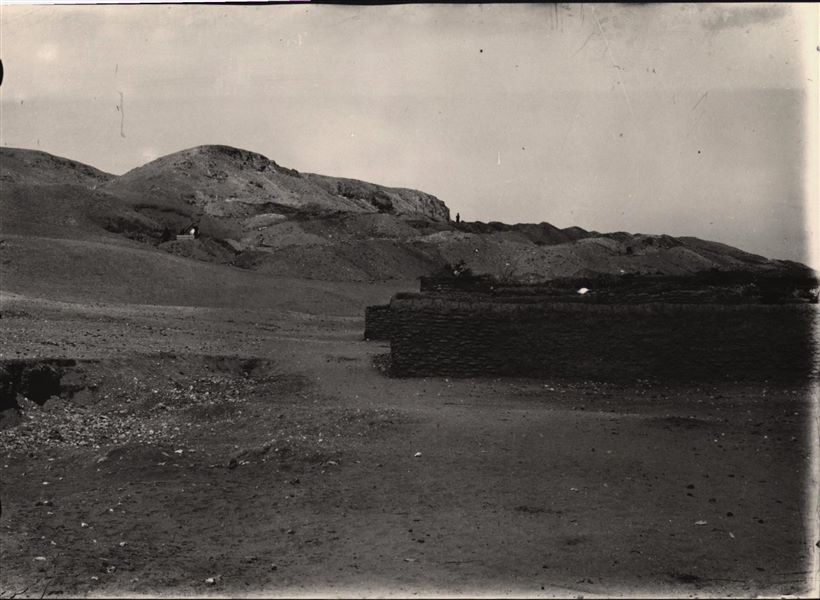
Excavations along the northern hillside, in the centre towards the left, there is a sarcophagus that has just been removed from a tomb. In the foreground, there are some dwellings from the village of Abu Hummas. Schiaparelli excavations.
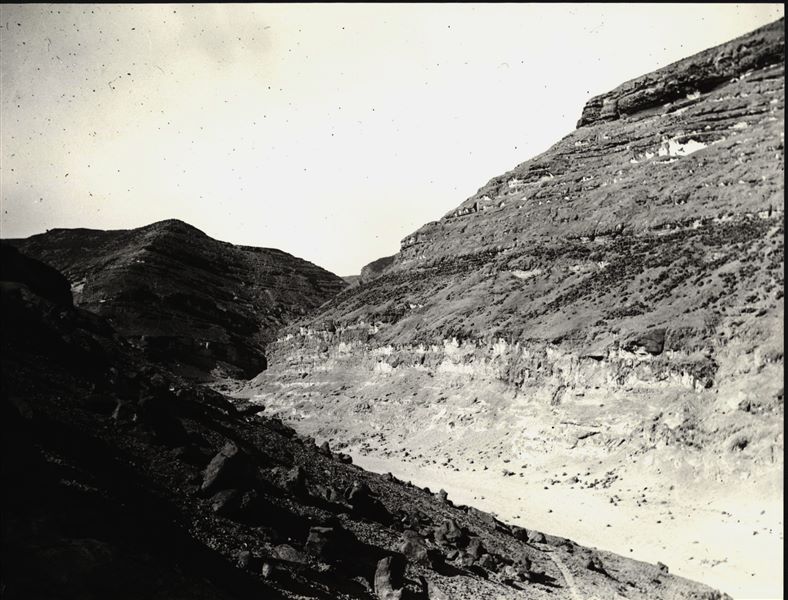
Mountainous area of the northern hill. Schiaparelli excavations.
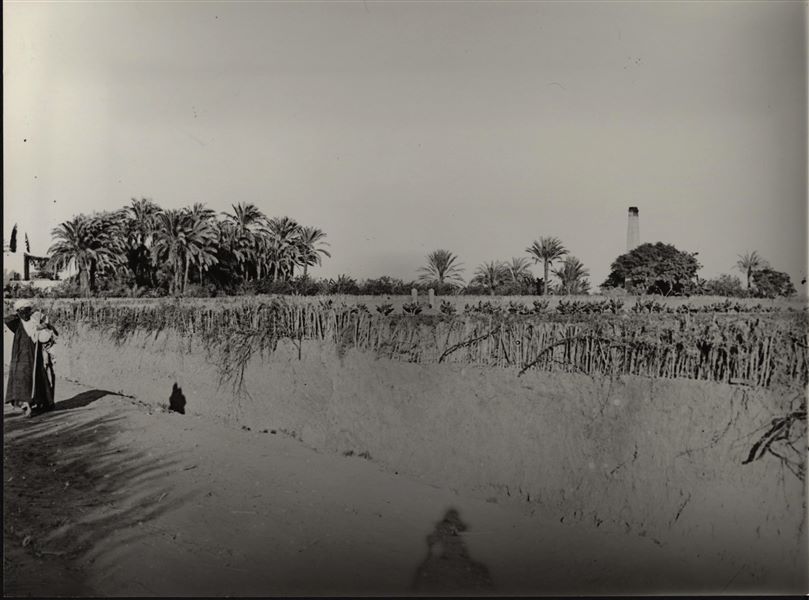
Crops organised in gardens on the edge of a village. In the background, there is a chimney from a brickmaking factory. Schiaparelli excavations.
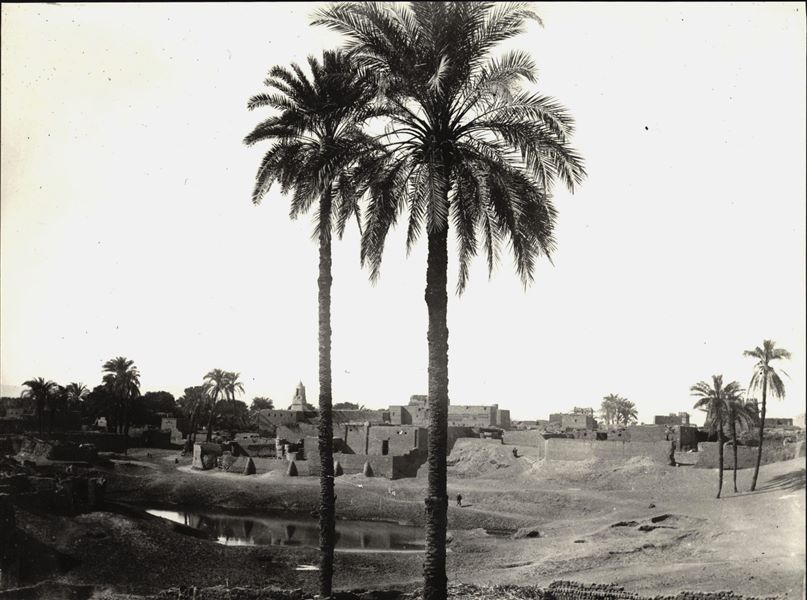
Partial view of the village of Naga el- Gherira, the minaret of the local mosque is visible on the left. Schiaparelli excavations.
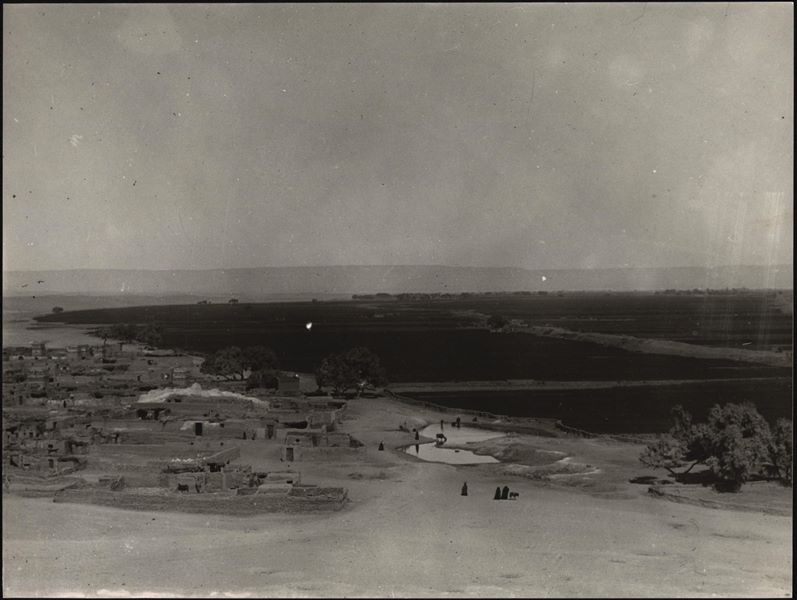
View of the southern area of Naga el-Gherira, pools of water left by the Nile floods can be seen. Schiaparelli excavations.
Wall of a modern farmhouse in the countryside near Gebelein. The mission’s excavations are visible in the background, and the man with the parasol could be Schiaparelli, as he usually carried one with him.
Two adult Egyptians and a child in front of a modern mud-brick fence, photographed during excavations, which can be seen in the background, on the northern hill at Gebelein. Presumably Schiaparelli excavations.
Modern enclosure at Gebelein with some Egyptians walking. Behind this, on the hill, excavations by the Italian Archaeological Mission were taking place. Presumably Schiaparelli excavations.
Excavations in the Gebelein plain in front of the northern hill. Schiaparelli excavations.
Egyptian workers excavating on the northern hill of Gebelein. There is a porticoed brick structure at the foot of the hill, west of the village of Abu Hummas. Schiaparelli excavations.
Northern area of the first hill prior to the start of excavations. In the background, the modern village of Naga el-Gherira, in the foreground the houses of Abu Hummas. Farina excavations.
Northern area of the first hill prior to the start of excavations. In the foreground, the village of Abu Hummas. In the background, the Nile. Farina excavations.
Northern area of the first hill prior to the start of excavations. Signs of numerous un-authorised excavations can be seen. Farina excavations.
View of the northern hill. Excavation works in search of the ancient stratigraphic level. Notable is the quantity of workers employed, some over 400. In the centre, there are donkeys carrying water for the workers. Schiaparelli or Giulio Farina excavations.
View of the northern hill. This photograph connects perfectly with C00688, allowing for a more extensive view of the hill. Schiaparelli or Giulio Farina excavations.
Excavation area overlooking the village of Abu Hummas. In the foreground, the entrance to a large rectangular shaft. Farina excavations.
Excavation area overlooking the village of Abu Hummas. Access to some shafts, prior to the beginning of excavations. Farina excavations.
Excavation area overlooking the village of Abu Hummas. Workers are removing the excavated material from one of the shafts visible in image B00559. Identifiable starting from the left: Giovanni Marro, Michelangelo Pizzio and Giulio Farina. Farina excavations.
Excavating a large rectangular shaft and recovering skeletal remains. Farina excavations.
Excavating a second rectangular shaft, with the access bordered by mud- brick layers. Farina excavations.
Access to the shaft visible in B00607, a young worker demonstrates the way to descend into and come out of the shaft using the support points cut into the masonry during ancient times. Farina excavations.
Excavations on the northern part of the hill, close to the last section of buildings from the village of Abu Hummas. In the foreground, the Director of the mission, Giulio Farina. Farina excavations.
Excavations north of the hill, remains of a mud-brick structure. Workers at rest. Farina excavations.
Northern area of the hill, prior to starting excavations, the remains of mud-brick structures are visible. Farina excavations.
Excavations north of the hill, to the left Giulio Farina wearing a pith helmet (colonial style helmet) and on the right is the anthropologist Giovanni Marro. In the centre is the figure of the rais or “chief” of the workmen. Farina excavations.
Excavations north of the hill, the anthropologist Giovanni Marro. Farina excavations.
Excavations north of the hill, in the centre is Giovanni Marro, partially covered by the rais or “leader” of the workmen. Farina excavations.
Excavations north of the hill, along the slopes. On the left, fragmentary remains of wooden sarcophagi. Further towards the centre of the image, is a box containing photographic materials and a foldable chair. Farina excavations.
Systematic approach to excavations, north of the hill. Farina excavations.
Excavations north of the hill. Several teams of workmen can be seen working in separately assigned excavation areas. Farina excavations.
Excavations north of the hill. In the centre, Giovanni Marro and Giulio Farina. Farina excavations.
Excavations near the last section of houses from Abu Hummas. Giovanni Marro is visible on the far right and the camp’s tents can be seen among the trees. Farina excavations.
Excavations near the last section of houses from Abu Hummus. The excavation is aimed at locating the depressions that highlight the presence of burial shafts. Farina excavations.
Excavating near the last section of houses from Abu Hummus. To the right of the modern house seen here, the camp’s tents are visible among the trees. (Still) on the right, Giovanni Marro is assisting with excavations. Farina excavations.
Excavations along the slope of the hill, west of the village of Abu Hummas. The Nile is visible on the horizon, and beyond is the mountain range of the Eastern Desert. Farina excavations.
Excavations along the slope of the hill, in front of the houses from the village of Abu Hummas. The photograph shows Michelangelo Pizzio in the centre and Giulio Farina on the left. Farina excavations.
The village of Abu Hummas: houses, animal pens and in the background, pigeon houses. Farina excavations.
Continuation of excavations along the northern slope of the hill. Visible in the foreground are tomb shafts and brick structural remains, still buried. On the right, Giulio Farina under a white parasol. Farina excavations.
Excavations in the desert area east of the northern necropolis. Identifiable in the background among the workers, Giovanni Marro on the left and Giulio Farina in the group on the right. Farina excavations.
Northern necropolis. Burial pits, the remains of the mats which the dead were wrapped in are still visible. In the central pit, a terracotta boat or granary model can be seen. Farina excavations.
Northern necropolis. Burial pits, the remains of the mats which the dead were wrapped in are still visible. In one pit, a terracotta boat or granary model can be seen. Farina excavations.
Northern necropolis. Burial pits, the remains of the mats that the deceased were wrapped in are visible. In one of the pits a terracotta model boat or granary can be seen. Farina excavations.
Northern necropolis. Burial pits, the remains of the mats that the deceased were wrapped in are visible. In one of the pits a terracotta model boat or granary can be seen. Farina excavations.
Northern necropolis. Burial pits, human remains with grave goods beside them. In the grave in the centre, the deceased is still wrapped in matting. On the left, there is a hoe and a basket, used to remove excavated material. On the right, Giovanni Marro can be seen holding an artefact in his hands, with Giulio Farina next to him. Farina excavations.
Northern necropolis. Burial pits, human remains with grave goods beside them. In the central grave the deceased is still wrapped in matting. In the grave to the side, a disc of woven straw. Farina excavations.
Northern necropolis. Burial pits. In addition to the deceased wrapped in matts, there are also numerous vessels coming from the excavation. On the left of the image, some of them can be seen scattered. Farina excavations.
Northern necropolis. The openings of the large tomb shafts are visible, which have brought forth numerous deceased with their respective grave goods. Visible on the left, Giovanni Marro, the rais (leader of the workmen) Giulio Farina and Michelangelo Pizzio.
Northern necropolis. Systematic excavation searching for the ancient stratigraphic layer. This picture shows all the members of the mission: on the left Giovanni Marro, on the right Giulio Farina and Michelangelo Pizzio who is wearing a white helmet. Farina excavations.
Northern necropolis. Systematic excavation searching for the ancient stratigraphic layer. Visible on the right, Giulio Farina and Michelangelo Pizzio. Farina excavations.
Northern necropolis. Cemetery next to the (Egyptian) prehistoric one. Rectangular pit tomb, with mud-brick roof sealed with mud. Farina excavations.
Northern necropolis. Cemetery next to the (Egyptian) prehistoric one. Rectangular pit tomb, with mud-brick roof sealed with mud. Farina excavations.
Northern necropolis. Cemetery next to the (Egyptian) prehistoric one. Rectangular pit tomb, with mud-brick roof sealed with mud. Farina excavations.
Northern necropolis. Cemetery next to the prehistoric one. Rectangular pit tomb, with mud-brick roof sealed with mud. Visible on the right, Giulio Farina. Farina excavations.
Northern necropolis. Access to a shaft dug in the rock. The wall of bricks and stones, which closes the passage to the burial chamber, is visible at the bottom. Farina excavations.
Northern necropolis, south of tomb of Iqer. Unidentified room with barrel-vault. Farina excavations.
Northern necropolis, south of tomb of Iqer. Unidentified room with barrel-vault. A niche can be seen on the back wall. Farina excavations.
Northern necropolis, south of tomb of Iqer. Excavation of a large unidentified pillared tomb. In the centre, the partially collapsed vault of the central chapel, and the figure of Giovanni Marro. Farina excavations.
Northern necropolis, south of tomb of Iqer. Corridor with pillars from an unidentified tomb. Farina excavations.
Northern necropolis. Mud-brick structure with a false door. Unidentified tomb. Farina excavations.
Walled up entrance to a tomb. Schiaparelli or Farina excavations.
Entrance to a tomb at the time of discovery, the interior of the small room with its contents can be seen. The image was taken using magnesium flash photography. Probably from excavations in 1911 conducted by Virginio Rosa, a collaborator of Ernesto Schiaparelli. Schiaparelli excavations.
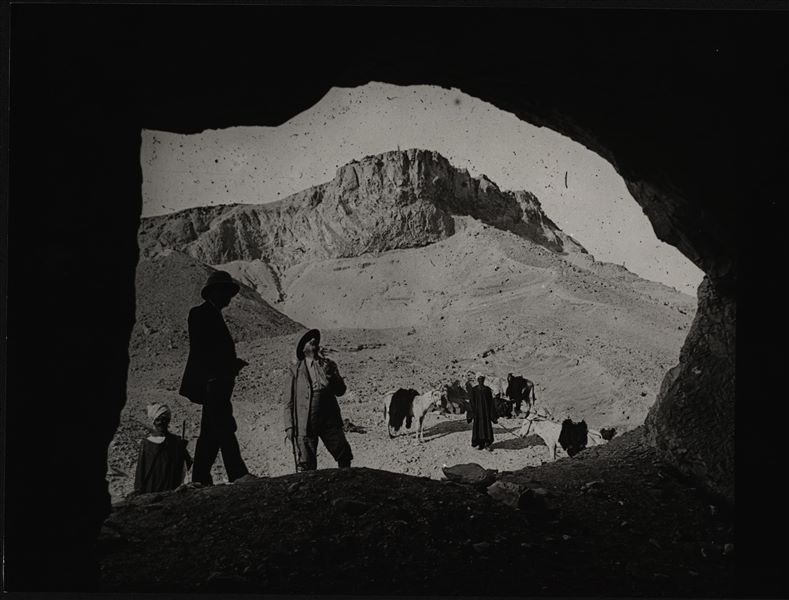
Giovanni Marro and Giulio Farina during the 1930 archaeological campaign in Gebelein. Farina excavations.
Giulio Farina (centre), Giovanni Marro (left) and some Egyptian men during a patrol at the entrance to a cave near Gebelein. Farina excavations.
Giulio Farina, Giovanni Marro (left) and an Egyptian man during a patrol in a cave near Gebelein. Farina excavations.
General view of the plain around Gebelein.
View of the landscape around Gebelein, where some modern buildings can be seen.
Excavation area near Gebelein, with some Egyptian men, one of whom is on a camel. Slightly visible in the background, some areas where excavations were continuing.
Excavations at the northern hill in Gebelein.
View from above of a settlement presumably near the archaeological site of Gebelein.
A general view of Gebelein, with palm trees in the foreground.
Egyptian workers during excavations at Gebelein.
Egyptian workers on an excavation conducted by the Italian Archaeological Mission in Egypt, presumably at Gebelein.
Housing with typical Gebelein pigeon holes.
Housing with typical Gebelein pigeon holes.
View of the village of Gebelein.
Landscape near Gebelein, the Nile is visible behind the palm trees.
General view of the plain near Gebelein. In the background, the mountain range on the eastern side of the Nile.
Streets and housing in Gebelein. The houses have typical pigeon holes.
